SS-Standort Dachau (Part 7 and The end)
1945
January 25, 1945
The founder and long-time commander of the WTL, SS brigade leader and major general of the Waffen-SS Gustav Diesterweg from January 30, 1944, was transferred to the reserve leadership of the Waffen-SS in the SS leadership headquarters and replaced by SS-Standartenführer Albert Doerheit.
January 00, 1945
After the encirclement of Breslau, the “Functional Unterführerschule der Waffen-SS”, which had only been newly established in 1944, was placed under the command of the combat commander and was included in the fighting with the current 7th course of this type, which was to run until the beginning of March 1945.
The time when the school was re-founded in Dachau is not known.

SS field post from SS-Uscha. E. Woerner, 1./Funkt.Uffz.Schule der Waffen-SS 13 b Dachau 3 with postmark April 3, 1945 (imprint “Forwarding prevented by wartime conditions”)
to the Mayor Woerner family in Mühlacker, Württemberg, Hindenburgstr. 51
Dachau, Easter 1945. “Dear parents! First, my warmest Easter greetings. Unfortunately, this time we can’t celebrate it together like we did last year and unfortunately things look completely different this time. But there is still no reason to despair, everything will be fine.
I really hope that you are still doing well, because I haven’t received any mail from you in a long time, and it won’t be the case any time soon.
Hopefully you have received my last letters and….”
So this school existed in Dachau at the beginning of April 1945! Further information is missing so far (June 13, 2018)
February 19, 1945
57.Cooking course a. d. SS training kitchen Dachau 02/19/45 – 03/16/45
March 24, 1945
Action “Leuthen” in WW VII as part of the “Visigoth movement”:
According to the orders of the deputy Gen.Kdo. VII.AK (Wehrkreis-Kdo VII), No. 4952/45 case, Ib/Mob.1, II. Angel. On March 24, 1945, the formation of the “Bavaria Training Division” was ordered.
The Waffen-SS units in World War VII also mobilized as part of the “Gneisenau” call.
(Joachim Brückner, End of the War in Bavaria, individual writings on the military history of the Second World War 30 MGFA, pp. 40-41)
February 19, 1945
57.Cooking course a. d. SS training kitchen Dachau 02/19/45 – 03/16/45
March 24, 1945
Action “Leuthen” in WW VII as part of the “Visigoth movement”:
According to the orders of the deputy Gen.Kdo. VII.AK (Wehrkreis-Kdo VII), No. 4952/45 case, Ib/Mob.1, II. Angel. On March 24, 1945, the formation of the “Bavaria Training Division” was ordered.
The Waffen-SS units in World War VII also mobilized as part of the “Gneisenau” call.
(Joachim Brückner, End of the War in Bavaria, individual writings on the military history of the Second World War 30 MGFA, pp. 40-41)
March 31, 1945
“…the following scan is part of a letter that belongs to the Vilzmann document collection.
I will be happy to introduce this here soon, it recently came into my collection.

My question today:
This letter is from a blocking bag. Widmann, signature is from Captain Widmann, I can read it.
I think I can see the runes in the header.
Now there was an officer named Hans Widmann, who was a first lieutenant in the III./Gren.Rgt. 61 was awarded the German Cross in Gold on December 15, 1944. Vilzmann was also a member of the Gren.Rgt. 61 and this letter goes to the replacement unit 61. So I assume this Widmann is the first lieutenant from GR 61.
My question to you: What’s with this barrier bag? Widmann on himself. What kind of unit was that?
Since “Dachau” is mentioned as the place, I of course looked through the book “The End of the War in Bavaria” by Joachim Brückner – unfortunately without success, as did a Google search.
Can one of you help me?
Greetings – Armin. …” (Armin Rudzki in
https://www.forum-der-wehrmacht.de/index.php?thread/57048-ss-sperr-btl-widmann/
April 17, 1945
As early as April 4, 1945, the head of the WVHA ordered the division of the main office into two groups, “North” and “South”.
(Andreas Schulz, Dieter Zinke, Generals of the Waffen-SS and Police, Volume 4, Biblio, 2009, p.45)
“… On April 14, 1945, Official Group B was relocated to Munich as Group South. However, as a result of the war, we were no longer able to continue working…”
(Andreas Schulz, Dieter Zinke, Generals of the Waffen-SS and Police, Volume 3, Biblio, 2008, p. 51, note 37 as Georg Lörner’s CV dated November 30, 1945, arrived in Dachau on April 17, Georg Lörner and his older brother Johann “Hans” went on excessive drinking bouts, see also p. 44 Johann “Hans” Lörner, SS-Oberführer der Waffen-SS, among others from December 1st, 1942 – May 8th, 1945, head of the Office A I (budget office) in the WVHA)
On April 15, 1945, at around 5 p.m., the majority of the WVHA employees, including the head of the main office, SS Obergruppenführer and General of the Waffen-SS Oswald Pohl, moved to southern Germany. At their own request, employees were also able to stay in Berlin, where SS Oberführer Salpeter took over the remaining members of the WVHA.
Dachau was reached on April 17, 1945, but only the official groups A and B in southern Germany were still in operation.
The approximately 10 employees still at Staff W also went to Dachau under SS Oberführer Hans Baier.
A reconstruction of the SS administration was no longer possible due to the rapid advance of the Allies. Rather, the approximately 50 to 70 employees of Office Group A under SS Brigade Leader Heinz Fanslau and Office Group B, which was reduced to around 70 employees under SS Group Leader and Lieutenant General of the Waffen-SS Georg Lörner, concentrated on preparations for a further evacuation towards Bayrischzell.
The Amt D group, which initially remained in Oranienburg, under SS group leader and Lieutenant General of the Waffen-SS Richard Glücks, managed to maintain contact with the new headquarters of the WVHA thanks to a direct radio connection to KL Dachau. After Oranienburg was evacuated, this connection was completely broken off.
During the week that followed the retreat to southern Germany, Pohl stayed overnight at his wife’s property near Dachau, the Brüningsau estate, where his SS-Hstuf adjutant also stayed. Werner Schiller (* October 7, 2016, Oldenburg) and his OO, Witt, were alive.
(Jan Erik Schulte, Forced labor and extermination. The economic empire of the SS, Schöningh, 2001, pp. 427 – 428, see also (Andreas Schulz, Dieter Zinke, Generals of the Waffen-SS and Police, Volume 4, Biblio, 2009, p. 45, after which Pohl, Fanslau and Georg Lörner came from Berlin with 400 employees to Dachau, where Pohl stayed with 10 men, while the rest continued to “make their way”)
Pohl is said to have occupied a “command post” in the so-called plantation of KL Dachau from April 17th to 23rd, 1945.
(Andreas Schulz, Dieter Zinke, Generals of the Waffen-SS and Police, Volume 4, Biblio, 2009, p. 45)
April 16, 1945
59.Cooking course a. d. SS training kitchen Dachau April 16, 1945 – May 11, 1945
April 18, 1945
In view of the enemy forces advancing ever further into southern Germany, the personnel and courses at the SS Weapons Technical Training Institute (WTL der SS) Dachau were reorganized into combat companies from April 18, 1945.

20.04.1945
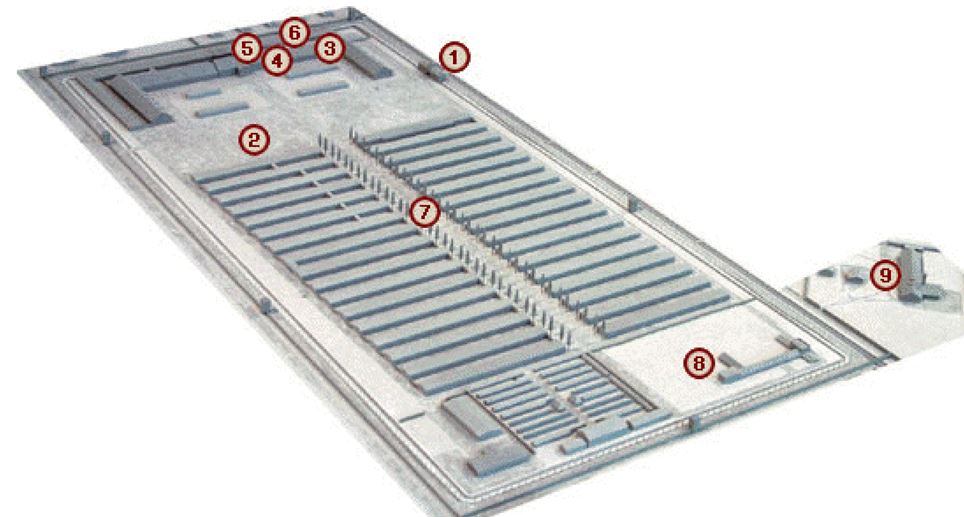
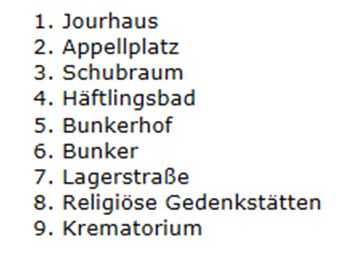
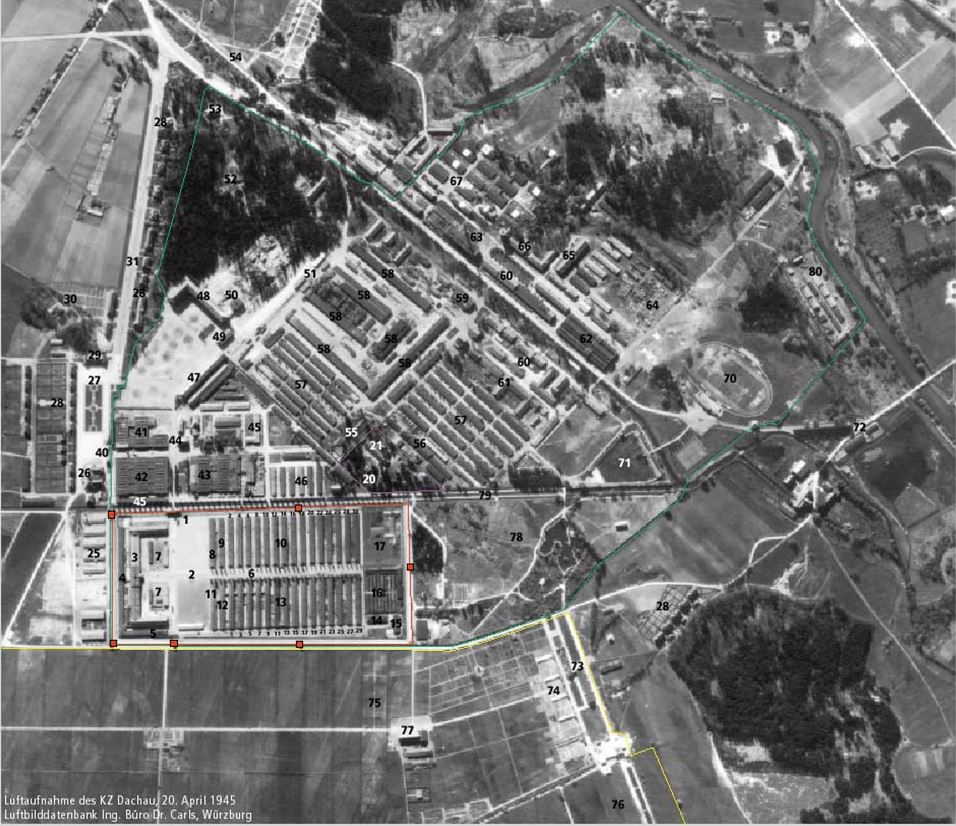
1 Jourhaus mit Lagereingang
2 Appellplatz
3 Wirtschaftsgebäude
4 Bunker
5 Straflager der Waffen-SS und Polizei
6 Lagerstraße
7 Materiallager
8 Lagermuseum, Kantine
9 Arbeitseinsatz, Messerschmitt-Werkstätte
10 Unterkunftsbaracken für Häftlinge (Block 2 – 30)
11 Krankenrevierbaracke A (Ambulanz, Operationssäle)
12 Krankenrevierbaracke B (Schreibstube, SS-Ärzte, Totenkammer)
13 Revier- und Quarantänebaracken (Block 1– 29)
Revierblock 1: Malariaversuche,
Phlegmone-Abteilung
Revierblock 3: Internistische
Abteilung, Malariaversuche
Revierblock 5: TBC-Abteilung,
Höhen- und Unterkühlungsversuche 1942
Revierblock 7: Krankenstuben
Revierblock 9, 11: TBC-Stationen
Revierblock 13 – 29: Quarantäne
14 Block 31: Sonderbaracke (Bordell)
15 Desinfektion
16 Ställe für Angorakaninchen
17 Lagergärtnerei
20 Altes Krematorium
21 Großes Krematorium
25 Werkstätten des Heereszeugamts
26 SS-Gemeinschaftshaus
27 Eickeplatz
28 Wohngebäude für SS-Angehörige
29 Gaststätte, Laden
30 Kommandantenvilla
31 Straße der SS
40 Torhaus / Eingang zum SS-Lager
41 Lagerbäckerei, Lager und Garagen SS-Bekleidungswerke
42 Lager der SS-Bekleidungswerke
43 Werkstätten der Deutschen Ausrüstungs-Werke (DAW)
44 Kommandantur des Konzentrationslagers
45 Politische Abteilung (Gestapo)
46 Baracken-Unterkünfte der KZ-Wachmannschaften
47 Besoldungsstelle der Waffen-SS
48 SS-Kaserne und Verwaltung
49 SS-Standortverwaltung
50 Luftschutzbunker (Hollerith-Bunker)
51 Tankstelle
52 Waldheim, Dienstwohnung SS-Standortkommandant
53 SS-Führerheim (Waldcasino)
54 Standort des Todeszuges bei der Befreiung
55 Hundezwinger
56 Zentralbauleitung der Waffen-SS und Polizei (Baulager)
57 Baracken-Unterkünfte für SS-Mannschaften
58 Garagen
59 (SS-) Porzellanmanufaktur Allach
60 Waffentechnische Lehranstalt der SS
61 SS-Bekleidungswerk/Schneiderei
62 „Holländer“-Halle (Lager und Werkstätten)
63 Fernheizwerk
64 Materiallager
65 SS-Führerschule des Verwaltungsdienstes
66 Reichsführer SS, Abt. „F“ (Dr. Fahrenkamp)
67 SS-Lazarett
70 SS-Sportplatz
71 SS-Schwimmbad
72 Entomologisches Institut
73 Plantage (Kräutergarten) Wirtschaftsgebäude
74 Gewächshäuser
75 Bereich „Freiland I“ der Plantage
76 Bereich „Freiland II“ der Plantage
77 Darregebäude
78 Wildpark
79 Würmkanal
80 Präzifix Werkstätten
April 23, 1945
On April 23, 1945, the head of the WVHA, SS Obergruppenführer and General of the Waffen-SS Oswald Pohl, left his “command post” in Dachau to seek safety from the advancing Allies.
(Jan Erik Schulte, Forced Labor and Extermination. The Economic Empire of the SS, Schöningh, 2001, p. 430)
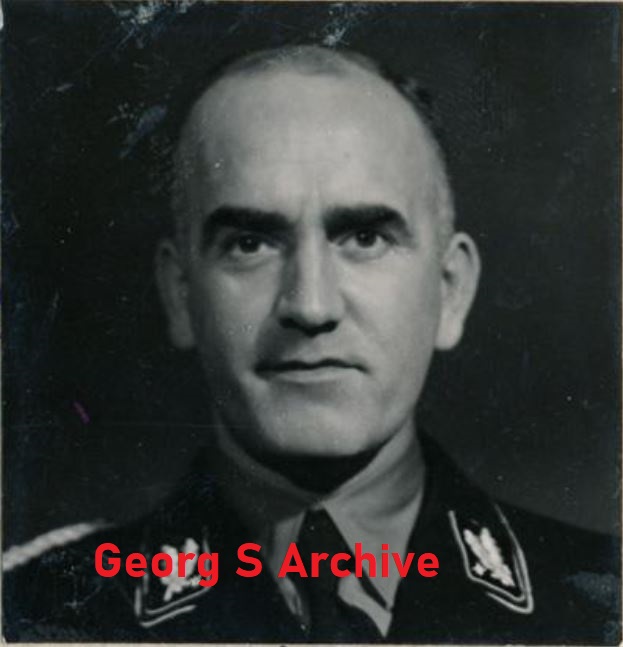
It is not known when the head of Office Group B of the WVHA, SS group leader and Lieutenant General of the Waffen-SS Georg Lörner, left Dachau.
He escaped with members of his staff into the mountains via Schliersee, Bayrischzell and Thiersee, Tyrol.
(Andreas Schulz, Dieter Zinke, Generals of the Waffen-SS and Police, Volume 3, Biblio, 2008, p.
51)
April 26, 1945
When the American troops approached the Munich area on April 26, 1945, additional combat units were put together from the troops stationed in the greater Munich area and the personnel of the offices and other facilities of the Waffen-SS and formed an SS unit with the combat companies of the WTL of the SS. Alarm Regiment “Dachau”, also known as SS Regiment Freimann, summarized.
As far as can be determined, the shutdowns were made by:
- the SS-Totenkopf-Wachsturmbann Dachau
- the Training and Replacement Abbot of the SS Administrative Services Dachau
- the salary office of the Waffen-SS Dachau
- the SS Weapons Technical Training Institute with 1st Inspection, SS-Ostuf. Karl Wolf
2nd inspection, SS-Ostuf Oskar Röntgen - the SS training kitchen in Dachau
- the SS clothing factory in Dachau
- the vocational school of the Waffen-SS Schleißheim (meaning: discharge point of the Waffen-SS
Schleißheim, the vocational school had already been moved to Mittweida, the author.) - Parts of the SS-Flak-AuE-Rgt Munich
- SS Guard Company 7 Munich
- Members of the Waffen-SS from the hospitals in Upper Bavaria
- Dispersed members of the Waffen-SS
- a remnant group from SS-GebJgAuE-Btl 6 Hallein under SS-OJ Hoy
The SS Volkssturm Battalion Augsburg (?, the author, but so WV) was also added, and a unit of SS pupils is also said to have been added to the regiment.
As the American troops approached Munich on their advance from the area north of Augsburg, the discharge center of the Waffen-SS Schleißheim was closed on April 28, 1945.
Parts of the permanent staff as well as members of the “transit company” volunteered for the SS Alarm Regiment Dachau. (see also manuscript WV discharge office of the Waffen-SS)
The commander was the previous commander of the SS Weapons Technical Training Institute, SS-Standartenführer Albert Doerheit.
The staff consisted almost exclusively of Bavarians or Ostmarkers.
According to unconfirmed information, the regiment was divided into two battalions. Individual units assigned to the regiment sometimes operated independently.
Deployed until April 29, 1945 to secure the greater Munich area, including the Isar bridges in Munich itself.
(WV, see also Brückner, End of the War in Bavaria, pp. 199-200, 202, 205, Stöber, XIII.SS-AK, pp. 342, 344)
Operational strength of the units subordinate to the Central Protected Area according to the last available report from the Munich Military District Command, Lieutenant Colonel Hofmann, to the deputy. Gen. Kdo VII of April 26, 1945, Az So., File 13 g – K./Ia: Accordingly, the Wehrmacht (since April 23, 1945 “combat”) commander only commanded one company of the army from the grenadier replacement and Training Battalion 19 with a strength of 4 officers, 23 non-commissioned officers and 144 men. The interpreter company in World War VII was not intended for combat use.
SS units in Freimarn, SS-Flak-AuE-Rgt, and Dachau, WTL of the Waffen-SS, were ready for enemy attacks against the northern outskirts of Munich; their combat strength was less than 1,000 men each.
The Volkssturm and the police could not be deployed as a unit. The seven companies of the Pioneer Replacement and Training Battalion 7 could not be counted on either, as they were divided into blocking squads and were not available as closed units.
(Joachim Brückner, End of the War in Bavaria, individual writings on the military history of the Second World War 30 MGFA, p. 182, BA-MA RW 17/48)
April 27, 1945
Munich was now threatened from the west and north, and Field Marshal Kesselring, as Mayor West, therefore feared that the enemy attacking from the west would push into the rear of the 1st Army via Munich. He therefore ordered a rear barrier to be prepared along the Isar, Amper and Glonn and from Ammersee to Schongau.
Major General Freiherr von Buddenbrock of the XIII.AK (Army) was tasked with exploring and preparing barriers in the Ammersee area and south of it. On April 26, 1945, company-sized units from the Munich area had already been relocated to the Glonn section near Odelzhausen – Sulzemoos and near Petershausen, Markt Indersdorf.
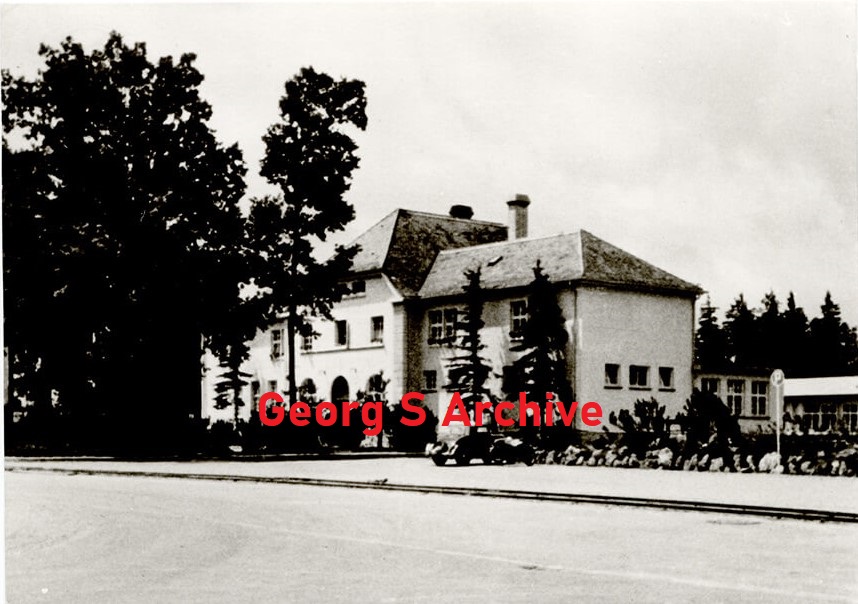
These were in each case the companies of the Weapons Technical Training Institute of the Waffen-SS, which belonged to the “Mitte Protected Area”. (Daily report from the Mitte protected area to the Deputy Gen.Kdo VII.AK from April 26th and 27th, 1945, BA-MA RW 17/46)
Explorations for such an operation had been taking place for a long time, because the greater Munich area with its Isar crossings north and south of the city could only be defended here, if at all.
(Joachim Brückner, End of the War in Bavaria, individual writings on the military history of the Second World War 30 MGFA, p. 181)
A first deployment of parts of the SS-Alarm-Rgt. Dachau, including a combat company of the WTL of the SS, took place on April 27th/28th, 1945 when suppressing a prisoner uprising in KL Dachau. (WV)
April 28, 1945
Deployment of parts of the Dachau Regiment, including SS-Wachkompanie 7 and combat groups of the SS-Flak-AuE-Rgt, against the “Bavarian Freedom Action”
April 29, 1945
On the night of April 29, 1945, the units of the KGr. von Hobe and the 2nd Geb Div moved behind the Amper and Glonn sections and again took up a front, the KGr. from Hobe on the Glonn section between Arnbach and the Augsburg-Munich motorway, on both sides of Freising behind the Amper section were the 352.VGD and the 2.GebDiv.
The 2nd GebDiv had to go on April 29th. Give up Freising and retreat behind the Isar. Into the front gap to the KGr. From Hobe, the 20th US PD pushed along State Road 13 to Schleissheim Airfield. Further west, the 42nd and 45th US ID reached KL Dachau around 1:00 p.m.
The camp was evacuated on April 26, 1945 by 7,000 prisoners, who over the next few days were driven in a miserable procession via Gauting, Percha to Waakirchen near Tölz. In the camp itself there were indescribable conditions. It was completely overcrowded with 30,000 prisoners who had been transferred here from other camps in recent weeks. Diseases had spread. Because of the international importance of this camp, the American armed forces had commissioned the Deputy Div.Kdr of the 42nd US ID, Brigadier General Linden, to take over the camp.
The handover was carried out by the head of the International Prisoners’ Committee, the Belgian Albert Guerisse, and on the German military side by a young first lieutenant who had recently been transferred to the Waffen-SS and had been in charge of camp management for a few days.
The American soldiers’ shock at the conditions in the camp was expressed in a massacre immediately after the handover: all SS guards were shot, including the first lieutenant who had just handed over the camp.
An eyewitness stated that the long-standing security personnel were constantly being replaced. After the partial evacuation in the final phase of the camp, young recruits from the Waffen-SS were then deployed to guard it. They atone for the guilt of others. In this context, the After Action Report of the 7th US Army speaks of 300 SS men shot.
The advance of the 42nd US ID to Dachau also tore the KGr apart. from Hobe, which tried to fight back on both sides of the Aichach – Dachau road. An SS regiment deployed north of Dachau was assigned to the KGr. Although now assumed, Hobe’s staff could no longer influence its management due to the interim capture of KL Dachau. The SS regiment was taken back to Freimann.
(Joachim Brückner, End of the War in Bavaria, individual writings on the military history of the Second World War 30 MGFA, pp. 192, 196, 198 – 200)
The SS Alarm Rgt. On April 29, 1945 (?), Dachau took up a defensive position north of Munich on the Glonn, including parts of the SS WTL, and on both sides of the Reichsautobahn Augsburg – Munich on the Lauterbach – Markt Indersdorf line. The command post was initially located in the SS troop camp at Dachau. (WV)
The SS regiment in KL Dachau was supposed to close a gap of 10 km to the right of the 212.VGD, south of Munich.
Instead, the Rgt. was deployed north of Munich, hard north of Dachau, and the KGr. assumed by Hobe. Rgts staff in KL Dachau was already deployed north of the Amper. The regiment, which then fought its way back to Freimann, prevented the Americans from advancing quickly toward Munich.
An SS battalion set up at short notice in Augsburg under SS-Hauptsturmführer Freiherr von Truchsess, which was to be added to the regiment, took up field positions near Webling and was engaged in defensive combat around midday on April 29, 1945. SS-Hstuf. von Truchsess and parts of his battalion were taken prisoner by the Americans in Webling and were subsequently killed along with 43 other members of the Waffen-SS.
(Günther, 17.SS, Vol. III, p. 405 – 406 SS-Hstuf. Heinrich Frhr.v. Truchseß, * 6. 4.02, SS-No. 14 962, 5.41 Ostuf. i. Kav.Rgt.2, 6.44 Hstuf. u. z.b.V., SS-Flak-Abt.9, † 29. 4.45)
The 212.VGD had left the Dachau area without orders from the XIII. SS A.K. Withdrew to Forstenrieder Park and came into the command area of the XIII. A.K. (Army).
The then O1 of the division Gottfried Pfeiffer reported on the background:
“… In the Dachau area we found ourselves in a “situation” that I would like to describe in particular detail because the behavior of my division was obviously not understood.
Our division stood north of Dachau without an enemy in front of the front in the north. Explorations to the left and right led to enemy contact.
Major Reinwald had a confrontation with an SS leader who was citing an order from Himmler that there should be no fighting in the Dachau area.
another tried to take our transport kit. (Capt. Kälble) to assume
others again the reconnaissance train.
At a train station north of Dachau we met the first Air Force members with “discharge papers” (!).
This was the situation when, dead tired, I arrived at the Div. Staff, where Gen. Ulich was desperately trying to establish contact with the XIII. SS A.K. to obtain…
After assessing the situation for several hours, Gen. Ulich made the decision to lead the division into Forstenrieder Park because, according to the unanimous opinion of all officers present, especially the Div.-Adj. Geyer, there was no longer any defense at Dachau. The division was urgently moved west of Munich.
The dramatic hours north of Dachau were more than turbulent… The unanimous verdict: This should be reported to the SS officer. released from the Dachau camp…
I think I can say from memory that the division “in the park” didn’t wait 24 hours for a new mission. All the more disappointing is the sudden news that Gen. Ulich will have to answer to a court-martial…”
(Erich Spiwoks, Hans Stöber, final battle between the Moselle and Inn, Munin, 1976, pp. 333 – 334, see also Keilig, General of the Army, p. 351 Max Ulich, born March 25, 1896, RK and DKiG, 1.12.44 Gen .Maj,, 1.4.44 – 31.3.45 Chief Gen.St. Deputy VII. A.K., 1.4.45 212.I.D., survived the war, then lived in Munich)

On April 29, 1945, the SS hospital in Dachau was handed over by the head doctor, SS-Sturmbannführer Dr. med. Schröder (possibly also Schroeter?), to the American troops who occupied Dachau.
After the proper handover, numerous seriously wounded people and members of the hospital staff were shot indiscriminately by the American soldiers.
(BA-MA N 756 Wolfgang Vopersal, SS-Lazarett Dachau, undated, 2 pages, here p.1 and 2 above)
Schroeter, Erwin Dr. Hstuf. 26. 6.07 401 306 SS hospital Dachau 11.44
Hstuf. Danzig SS-FHA 5.44
Unfortunately, there is no map in the chronicle of the 42nd US Division that shows the division’s route to Dachau or Munich.
It is mentioned in the chronicle that at 05:00 on April 29, regimental combat groups were formed to accelerate the division’s advance, and at 06:35 the motorized II./US-IR 222 followed behind the tanks (the 20th US- Pz.Div., the author) towards Munich, the I./222 followed the II. Btl. while the III. Btl. combed the regimental section and dug out isolated pockets of resistance.
It was similar with the US-IR 242, the III. Btl. was motorized, the I. Btl. followed the III. and the II. Btl. took care of the Rgts. section.
The US-IR 232 followed the CCA of the 20th US Pz.Div. and then entered the reserve of the XV in a meeting room. Corps.
At 1 p.m. the II./US-IR 222 reached Dachau, but only a small group of officers from the US-IR 222 and men under Brigadier-General Linden went to the camp.
According to the chronicle, the Dachau camp was handed over by a representative of the Swiss Red Cross. “A young German (first) lieutenant (in the original just “Luitennant”), who had been brought to this camp from the Eastern Front just two days earlier, “surrendered it” to the general.”
Then the II Btl. advanced and wiped out the SS guards, who refused to surrender and opened sniper fire on the advancing Americans.
After clearing the camp, the II./US-IR 222 continued its advance to the Amper and towards Munich.
The US-IR242, which traveled over the highway, also reached the Amper by the evening of April 29, 1945.
Management of KL Dachau, among others
SS Obersturmbannführer Martin Weiss
SS-Obersturmbannführer Eduard Weiter – April 26, 1945
(Rolf Michaelis, The Waffen-SS. Myth and Reality. Documentation about the personnel composition and deployment of the Waffen-SS, Berlin, 2006, p. 328)
Letter from the head of the security police and the SD – IV – g.Rs., v. April 5, 1945 to the commander of KL Dachau, SS-Obersturmbannführer Next – Personal
(Topography of Horror Foundation, Berlin, 2010. P. 110 from PS Best, The Venlo Incident, 1951)
SS Ostubaf. Martin Weiß, “Amtschef z.b.V.” in Office Group D of the SS-WVHA since May 18, 1944, was in Dachau again at the end of April 1945, possibly to relieve the camp commandant Eduard Weiter and to eliminate grievances.
On April 28, 1945, he discussed the handover of the camp to the US Army with SS-Standartenführer Kurt Becher.
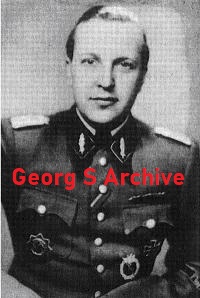
On April 28th or 29th, 1945, Weiß left Dachau. On May 2, 1945 he was captured by American troops in Mühldorf am Inn.
https://de.wikipedia.org/wiki/Martin_Gottfried_Wei%C3%9F
The SS-Standartenführer (since January 1, 1945) Kurt Becher was appointed “Reich Special Commissioner for all concentration camps” on April 9, 1945.
It is not known how long he stayed in Dachau; he was arrested by American military authorities in Nuremberg in May 1945.
He is said to have been in Bergen-Belsen on April 10, 1945, until he arrived in Mauthausen on May 5, 1945. Becher and some of his staff hid in Weißenbach (north of Altausee?) until he was arrested by the Americans on May 12, 1945.
(Karla Müller-Tupath, Reichsführer’s most obedient cup. A German career, Konkret Literatur Verlag, 1982, pp. 121 – 122, in Weißenbach were:
Kurt Becher, born September 12, 1909 Hamburg,
SS-Ostuf. Karl Grabau, born October 10, 1911 Hamburg
SS-Ostuf. Josef Weber, born September 25, 1911 Bodenbach/Elbe and their driver
Kurt Helfer, born November 1, 1919 Rielasingen/Baden
SS Oscha. Emil Wolff, born September 18, 1909 Sternbeck/Krs. Oberbarnim, “Reservists of the Waffen-SS”)
Grabau, Karl, born on October 10, 1911, in Harburg, head of the SS site administration in Radom June 42-June 43, SS Obersturmführer. SS no. 228 822?
Camp management: Martin Weiß from April 26 to April 28, 1945, Johannes Otto on April 28, 1945, and Heinrich Wicker on April 28 and 29, 1945. The handover to the American troops was carried out by the 23-year-old SS-Untersturmführer Heinrich Wicker
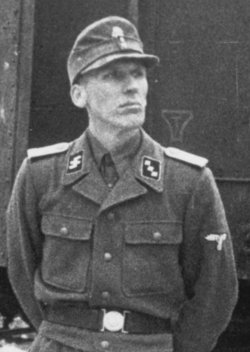
Otto, Johannes Ostuf. 12/24/06 292 442 SS-WVHA Amtgr. D 8.43
Ustuf. Oederan SS-WVHA Amtgr. D 1.42
The former prisoner Edgar Kupfer-Koberwitz also remembered April 29, 1945 in his Dachau diaries: “… Suddenly the news: There are white flags on the towers! Everyone is delighted, which can only mean that the camp has surrendered. I don’t believe it myself, I think it’s just to make the boundaries of the camp clear, and there’s still the SS on the towers, there are supposed to be 200 SS men still in the camp.
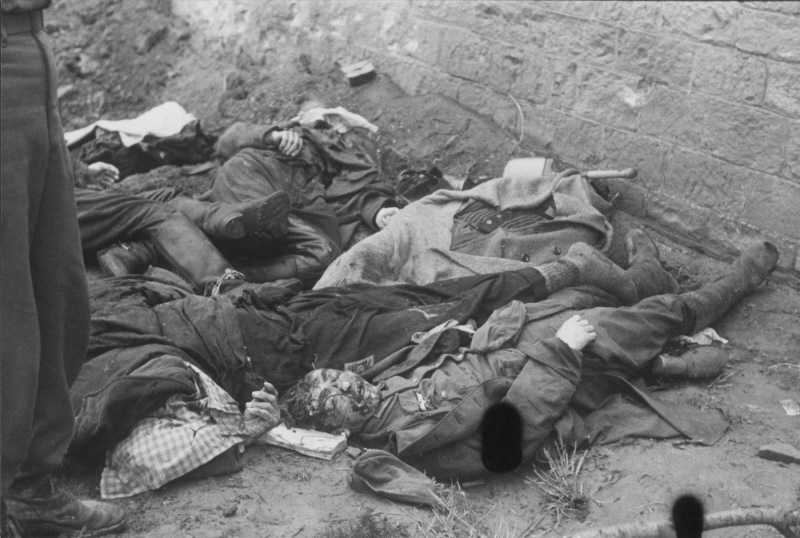
Suddenly outside there is shouting, running, running: The Americans are in the camp, yes, yes, they are at the roll call area! Everything starts moving, the sick leave their beds, the almost healthy and the staff run onto the block…
Comrades come, come back, talk breathlessly: The Americans on the roll call square! They shoot down all the SS. The camp is taken, we are free, free!
The Americans ordered the guards to climb down from the towers and come out of the bunkers… Everyone was shot, the Americans didn’t leave any of the SS men who fell into their hands alive. A comrade who saw this then told me what he felt, because it horrified him to see how people were shot down despite their hands raised, falling, bleeding and dying moaning…
The dead SS men are now lying everywhere in the camp area…. Some… take away the wristwatches, cameras and even the boots from the dead SS…
I’ve just heard that agitated prisoners snatched the submachine guns out of the hands of the US soldiers and shot the SS men, their hands raised to me as they stood behind the electric wire fence. Many comrades were outraged about this…
It was a beautiful and yet such a bloody Sunday. Strange how everything comes full circle the way it began. It all started bloodily and ended bloodily
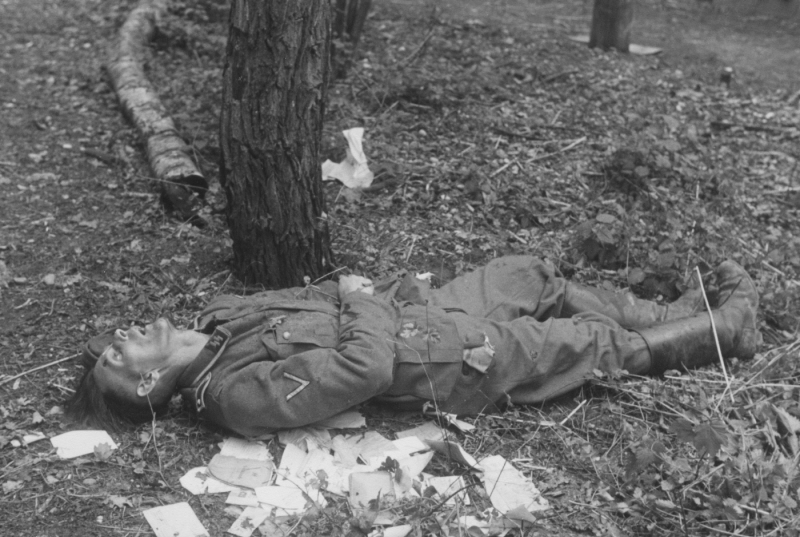
After the capitulation, Jost W. Schneider came from the Rottach-Egern camp via Berchtesgaden and the Oberpfaffenhofen airfield work detail to the Dachau camp and Bunker I around August or September 1945. In this context, he remembered that “… as a German doctor Stubaf./Ostubaf. Dr. Fierlings,
Fierlings, Paul Dr Stubaf. 18. 3.05 308 833 IVb,Pz.GR.95 4.45
Stubaf. Düsseldorf IVb,II./Art.Rgt.6 4.44
At that time he was, in my opinion, a bad assistant to the Americans…”.
“… out of the bunker, in the hospital, i.e. H. Around spring/summer 1946, I saw the “defense line” north of the camp complex, built-in Panzer III and IV cupolas at various work detachments, all of which were installed in the direction of Amper and Moor. These things were no longer fired, as several prisoners assured me.
In the warehouse itself from April 28th. Numerous prisoners armed themselves with the weapons they had from Staf. Dryness
Doerheit, Albert Staf. 20. 9.94 44 483 SS-WTL 1.45
Ostubaf. Blocks Kdr. Landstorm Nederland 4.44
Ostubaf. Kdr.Nachsch.9 2.44
Stubaf. Kdr.T.I.R.15 6.40
W.T.L. (Weapons Technical Training Institute, the author) had to repair them and tore them out from under the wooden floors of the barracks. Since the permanent staff had been piled up and moved with transports, the camp towers were mostly occupied by disabled people from the location area. These guards were attacked when the Americans approached and mostly killed; only a small number survived through the intervention of sensible prisoners.
Around 15 – 25 Waffen-SS (members) of all ranks were also murdered at the district heating plant in the on-site storage area, some of them animalistic (1 picture in my archive, not available, the author.)
The conditions up to 1947 and beyond were described to me by the camp priest Leo Roth, a Dominican priest who was (allegedly) imprisoned because of Section 175, who remained in the camp area after the liberation and took over pastoral care for the Waffen-SS. He knew a lot and gradually it became a pleasure to discuss with him. He, whose work had not yet been sufficiently appreciated, made himself unpopular with his superiors through his support of the Waffen-SS, even though Auxiliary Bishop Neuhäusler himself consecrated the chapel in the KL area on Christmas 45 (or 46?). Roth gave such a clear speech against collective guilt at the CIE-Langwasser that he had to go into claustry somewhere in South Tyrol for months. …Roth helped bring the truth to light despite the Dachau KL Museum: that PoWs had to build the “oven” in the crematorium long after the camp had been liberated (at which pot-bellied French ex-prisoners celebrated their “les rescapees de Dachau”) with bronze … (unles.)) – as well as the fact that the shower bath was just a bath and never a gas chamber.
In the 1960s he was “caught” again; one day his body was found on a relatively harmless rock face in the Dolomites. His end, like many things in his troubled life, remained mysterious. …”
(Jost W. Schneider, regarding question 309 a the JS Tölz in June 1945 – DF 1/1975, another memory of the Junker school, January 1975, BA-MA N 756, 2 pages, pp. 1 – 2 middle to Wolfgang Vopersal dated January 26, 1975)
https://de.wikipedia.org/wiki/Leonhard_Roth_(cleric)
With that we close the story about the SS-Standort Dachau. I hope you all have found it interessting. The SS-Standort Dachau is so big all of those departments and units can be devided in more detailed stories. One of them that I will publish a story about is the last Officer of KL Dachau – SS-Ustuf Heinrich Wicker. But more about that later. Thank you Roland for a very interesting story.
Georg Schwab
Author Roland Pfeiffer, some images Georg Schwab
SS-Standort Dachau (part 6)
1942
At the shooting range of SS-Standort Dachau you had the range at “Herbertshausen”, it´s 2 kilometers away north from the main camp. On this place the SS beside shooting practice conducted a war crime when they executed a lot of Russian POW´s there. the exact number is unknown. But we can count them in thousand. This kind of executions took place at several SS-Standorten such as Sachsenhausen, Buchenwald and other places. At Sachsenhausen they had a facility where the POW was supposed to get a medical check, and when they was telling him that they needed to measure his hight the POW took place by the wall, behind the wall an SS-Soldier stood ready with a gun. He opened a hatch a shot the POW in the back of the head. One of them was the so Called “pistolen schubert”.
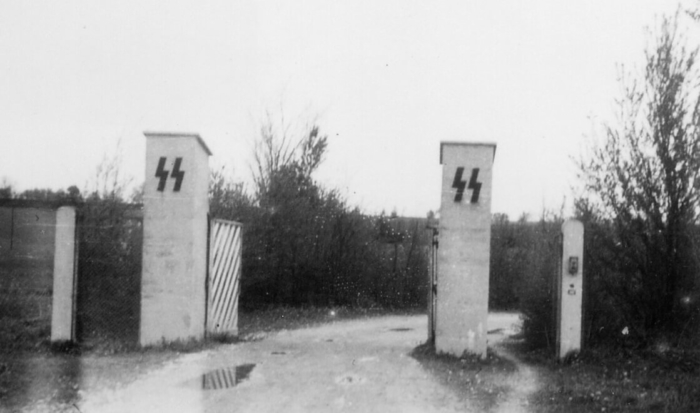
The new Kommandant of the camp was in 1942 SS-Ostubaf Martin Weiss, who came from KL Neuengamme.
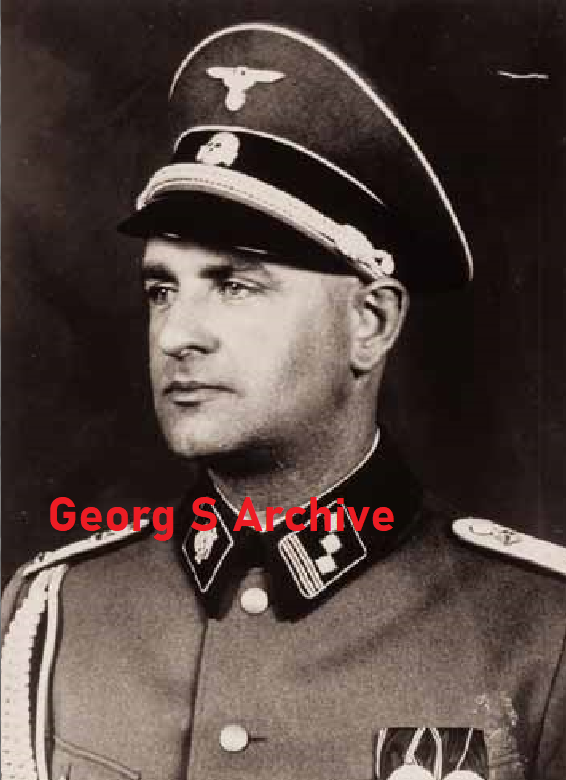
April 00, 1942
The Dachau SS Medical School, which was attached to the Dachau SS Hospital until 1942, was apparently closed in April 1942. Unfortunately, no further information is available on this, nor on the continued use of school staff.
(BA-MA N 756 Wolfgang Vopersal, SS Hospital Dachau, n.d., 2 pages, here p.1, see also BA-MA N 756 Wolfgang Vopersal, SS Medical School Dachau, n.d., 2 pages, here p.1)
However, the school reopened in December 1942 (field post receipt). Unfortunately (June 13, 2018), details are not known.

SS-Standortkommandant Dachau, 28.1.1943 SS-Oberführer Pfannenstiel
With effect from November 1, 1943, an SS regular company, e.g. V., was set up in Dachau. ordered.
- General:
a) The SS main company e.g.b.V. receives the designation
SS Stamm-Company e.g.V.
(SS Stammkp e.g. V.)
b) Leader of the SS Stamm-Kp. e.g.V.: SS-Hauptsturmführer Harms
He receives disciplinary powers according to DBO (mob) § 9.
c) The SS Stamm-Kp. e.g.V. reports directly to the SS Main Command Office. She works closely with Amt A II, Org.Abt. IE, instructed. Economically, the company is assigned to the SS location administration in Dachau.
d) Responsible for the formation of the SS Stamm-Kp. e.g.V. is SS-Hauptsturmführer Harms.
The completed list is sent to the SS-FHA, Org.Abt. Yes to report.
e) Postal address: SS-Stamm-Kp. e.g.V. Dachau 3/0 SS barracks.
2.) Structure:
A KStN does not apply to filling positions
3.) Personnel regulations:
Permanent staff are to be assigned by
SS-FHA Office V/IIa: 1 leader (seriously injured) as representative of the Kp. leader
1 guide for Abbot VI
SS-FHA Office II Org. Abt. IE: 1 staff sergeant
Additional permanent and training personnel will be formed into the SS-Stamm-Kp upon request by the SS-FHA, Org.Abt.IE. e.g.V. offset.
4.) Material provisions:
a) Weapons (for teaching purposes only) and training equipment will be provided upon request by SS-FHA, Org.Abt. Ib, assigned.
b) 2 le. Draft horses are to be assigned by SS-FHA, Office VI, the necessary harness equipment and 1 tow truck by SS-FHA, Office VII. takeover or The transfer must be made by mutual agreement.
c) Sports equipment, office supplies and equipment must be requested from SS-FHA.
d) Teaching materials are allocated upon request by SS-FHA, Regulations and Teaching Materials Department.
5.) Accommodation
First of all, accommodation with appropriate classrooms for 1,000 men must be provided by the SS Dachau location administration.
6.) Medical care is provided by the Dachau SS hospital.
7.) Tasks of the SS Stamm-Kp. e.g.V. are set out in a service instruction that is sent to the departments requiring cooperation. (not available, the author)
F.d.R. signed Hoffmann signed, Jü t t n e r
SS-Hauptsturmführer SS-Obergruppenführer and General of the Waffen-SS
(Copy from BA Berlin NS 19/ 1885 B.Arch.Kelling, provided to Uwe Kleinert 3.2008)
The formation of this company to record seriously injured members of the Waffen-SS was not only met with approval. Especially the head of the SS main office, the SS Obergruppenführer and general of the Waffen-SS Gottlob Berger, who only with effect from September 1, 1943, the SS convalescent battalion, the previous collection point for the troops’ war disabled people from the main welfare and supply office – SS had taken over the SS Main Office, saw this formation of the SS Main Office as a “competing company”.
Already in a letter dated October 29, 1943 to the Personal Staff of the Reichsführer-SS, SS-Obersturmbannführer Dr. Rudolf Brandt, CdSSHA/Be./We., VS-Tgb.No. 6768/43 case, Adjtr-Tgb.No. 3357/43, Berger explained: “Dear doctor!
It is unbearable for me to receive 1 or 2 things every day in which the orders or decisions given by the Reichsführer-SS are deliberately attacked. The matter is unbearable because I am certain that in the end I am the one who suffers, because a decision will either not be made or will be made in favor of the SS Headquarters. I’m tired of this now, and finally.
The Reichsführer-SS must intervene here and also point out to SS-Obergruppenführer Jüttner that he has to stick to the given orders and not constantly try – together with SS-Brigadeführer Dr. Haertel (the head of the main welfare and pension office SS, the author) – to sabotage the work. I am firmly convinced that the SS Stamm Company, for example, – which is what we are talking about here – is a competing company and so the uniformity is to be thwarted again.
It’s all pointless, and it would be best if my main office were to close down. What else should I do here? I have a big job to do at the front, but here at home I have to worry myself to death about things like this.
Letters arrive here every day. I submit today’s one to you. There are often up to 10 people who provide shocking evidence of how neither the main welfare and pension office nor the main management office did anything for the seriously injured. Now, after I took the matter into my own hands (taking over the SS-Gesenden-Btl., the author), you suddenly remember these things, and since you have all the technical and material possibilities, you can achieve this .
Dear doctor! You can say whatever you want this time. I’m too good to play the buffoon. Heil Hitler you…!”
(Copy from BA Berlin NS 19/ 1885 B.Arch.Kelling, provided to Uwe Kleinert 3.2008)
By March 1944 the SS Stamm-Kompanie z.b.V. For unknown reasons, probably due to lack of space, and at a previously unknown date, it had already been moved from Dachau to the SS “Germania” barracks in Hamburg-Langenhorn.
On March 23, 1944, the SS Obergruppenführer and General of the Waffen-SS Berger, CdSSHA/Be./We., wrote VS-Tgb.Nr. 211/44 g.Kdos, Adjtr.-Tgb.No. 193/44 g., again to the Personal Staff Reichsführer-SS, SS-Obersturmbannführer Dr. Rudolf Brandt, “Subject: SS Stamm-Kompanie z.b.V., Appendix: 1 process”: “Dear Doctor!
The Reichsführer-SS has ordered that I send you the report from my Office C III with all the appendices. In my opinion it is clear that this SS main company, for example, The SS Command Main Office has created a sieve through which only severely injured SS men who are no longer fit for action can get into the convalescent battalion.
“Hail Hitler, you…”
(Copy from BA Berlin NS 19/ 1885 B.Arch.Kelling, provided by Uwe Kleinert
1944
January 00, 1944
Relocation of the SS Leader School of the Administrative Service to Arolsen. (SS-Verwaltung Shule der SS)
In mid-November 1943, an SS advance commando from Dachau sounded out the SS barracks of the 2nd Battalion of the SS Regiment “Germania” on Große Allee in Arolsen, which had been empty after the SS Anti-Aircraft Training and Replacement Regiment had been relocated to Munich-Freimarn for accommodation options at an SS leadership school in the barracks. (Zimmer, Deckn.Arthur, p. 51)
On November 14, 1943, a transport list was compiled in the Buchenwald concentration camp, which included 11 German, 12 Polish, 7 Czech, 2 Luxembourgish prisoners as well as 1 Belgian and 1 Dutch prisoner, which was intended for the newly established external command at the SS leader school in Arolsen were. The prisoner Willy Apel was employed as a prisoner capo and reported after the war: “The SS leader school used to be in Dachau and was moved to Arolsen. Buchenwald then had to provide a work detail. … We were all loaded into a car, onto a truck with appropriate security, and drove off. … We had no idea where Arolsen was and what we would encounter. …” (Zimmer, Deckn.Arthur, p. 51, note 4 interview by B.Zimemr with W. Apel from October 23, 1987).
The Polish prisoner Ludwik Majka remembered the transport: “… In the afternoon our group – around 40 prisoners – was picked up by a truck type “Holzgas” with a tarpaulin. … The group of prisoners was guarded by six SS men – Croats in German uniform – who were sitting at the car door, the driver – a German – and the command leader sitting next to him. … We arrived in Arolsen on the same day between 9 and 10 p.m. The first few nights we slept on straw bags spread out between machines. …”
(Zimmer, Deckn.Arthur, p. 75, note 2, report from L. Majka to B. Zimmer)
For Arolsen… when putting together the transport of November 14, 1943, it had to be taken into account that it was an external commando within an SS barracks, so particular caution was required when selecting the prisoners. The profession was an important criterion.
According to the personnel file, ten of them were cooks, waiters or butchers, i.e. they practiced jobs that were urgently needed in the newly established SS leader school. The others had relative qualifications primarily for construction work, and only in three cases was no craft occupation listed: clerk, tax official, businessman. (Zimmer, Deckn.Arthur, p. 52)
The majority of staff and teachers at the SS Leader School of the Arolsen Economic and Administrative Service came from the SS barracks in Dachau, which was located directly next to the concentration camp, separated only by a narrow river.
Some prisoners were already assigned to work here, for example in the kitchen and in workshops. In the course of the relocation of the SS administration school or its expansion into the SS leader school of the economic administration service, in addition to the SS personnel, some prisoners from the concentration camp in Dachau also came to the SS barracks in Arolsen.
Former Dachau prisoner Bodgan Wozniak, who worked in the kitchen of the school in Dachau, recalled: “… Only a few people worked in the kitchen – about 14 in total. My boss’s name is K., an ethnic German from Tomaszow-Mazowiecki. … The boss among the waiters was called W., the head of administration was Wr. I also remember the accountant’s appearance. He was slim and had straight hair. … Our departure took place on December 23, 1943. … We took the train to Arolsen under the supervision of two older security guards. …” 9 men on the transport were German, 11 were Poles, 3 were Yugoslavs, 2 were French and 1 was Belgian. A total of 26 prisoners from KL Dachau were transferred to the Arolsen external command and, for administrative reasons, were formally transferred to KL Buchenwald on December 27, 1943.
Here, too, these were mainly craftsmen who were needed in Arolsen for work in the kitchen and workshops. In the monthly calculation for January 1944 for the Arolsen external command, the arrival of the Dachau transport was noted for January 7, 1944; the number of prisoners increased from 34 to 60. With a transport of a further 12 Poles and 6 Russians, the strength of the prisoner command in the SS barracks, together with the 20 prisoners from the Arolsen SS clothing camp, reached 98 male prisoners.
(Zimmer, Deckn.Arthur, pp. 101 – 103, Fig. 3.22, 142, for further development see also pp. 142-156)
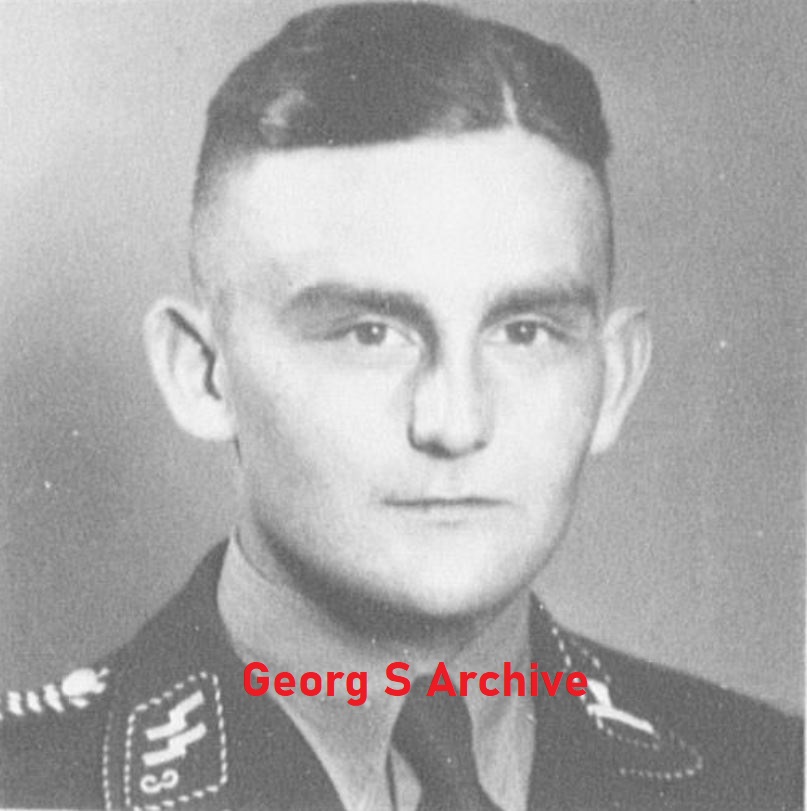
In January 1944 the school moved to Arolsen. Almost at the same time, in February 1944, it also received a new commander, SS-Oberführer Georg Bochmann, who was supposed to take over the school with effect from November 1, 1943, but whose transfer had been canceled at the time.
(Jan Erik Schulte, Forced Labor and Extermination, The Economic Empire of the SS – Oswald Pohl and the SS Economic Administrative Main Office 1933 – 1945, Schöningh-Verlag, Paderborn, 2001, 68)
In 1943 Eduard Weiter took over the Co´ of the KL Dachau. He would held this command until almost the end of the camp, april 1945.
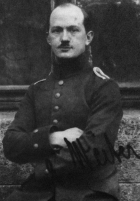
April 20, 1944
47.Cooking course v. April 20, 1944 – May 17, 1944 SS training kitchen Dachau
(Photo SS training kitchen Dachau in DF 4/74 inside back cover, the 48th course ran in Oranienburg from May 20th to June 17th, 1944, up to then around 1,750 troop cooks, kitchen bookkeepers and master chefs had been trained in Oranienburg, see also Kaienburg, Sachsenhausen , p. 344))
September 14, 1944
At the same time as other commanders, the commander in WW VII decided to fundamentally change the command structure in his military district. With the command deputy. Gen.Kdo VII.AK (Wehrkreiskommando VII), Az 35, No. 3010/44 g.Kdos, Ia, v. On September 14, 1944, this was now divided into “protected areas” and subordinate “protected areas” instead of the previous location areas. The accommodation areas of the two replacement divisions located in the WWF became protected areas:
Protected area “West” Div.No. 407 Augsburg
Protected area “East” Div.No. 467 Garmisch
Protected area “Mitte” location areas Munich, Fürstenfeldbruck
By order of March 16, 1945, Ref. A1, No. 1400/45, the Dachau district, previously the East Protected Area, was assigned to the Central Protected Area.
This reorganization of the military district served to increase the performance and training of troop leadership. The protected areas were divided into a total of 14 protected areas. The provisions on the subordination relationships stated: “.. All army troops located in their area and the alarm units of the Luftwaffe, the Waffen SS and the labor service are subordinate to the commanders of the protected areas….” A special feature should be mentioned that the Gauleiters also signed this order.
From then on, the respective troop commanders replaced the site elders in the protected areas and areas. The Central Protected Area, whose commander was the Wehrmacht commander from Munich, received its own general staff officer to align it with the two division staffs 407 and 467.
With the new protected area regulations, well-rehearsed staff members were now available for the ever-increasing territorial tasks. Simulation games for use against airborne landings and insurgent foreign workers were carried out everywhere in the following period.
(Joachim Brückner, End of the War in Bavaria, individual writings on the military history of the Second World War 30 MGFA, pp. 14 – 15, here BA-RH 53-7/1212)
November 00, 1944
- Cooking course at the “Waffen SS training kitchen” in November 1944 (found on eBay)
https://www.forum-der-wehrmacht.de/index.php?thread/23660-ss-lehrk%C3%BCchen/
November 00, 1944
At the end of October or beginning of November 1944, the SS main company z.b.V., which was originally set up in Dachau, returned to Dachau from Hamburg.
On November 15, 1944, the SS Main Office announced in the VOBl d. W SS, 5th year, 1944, v. 11/15/44, point 96 transfers, the transfer of the SS-Stammkp.z.b.V. from Hamburg-Langenhorn to Dachau. (N. Heitman dated March 7, 2000)
Apparently Dachau wasn’t supposed to be the “last solution”, but actually Graz-Tobelbad.
In the Ordinance Gazette of the Waffen-SS, 6th year, 1945, No. 3 from February 1st, 1945 it is stated under
Number 99 Deployment to the SS Stamm-Kp. e.g.V., arranged:
From the SS Stamm-Kp. e.g.V. So far only parts have been relocated to Graz – Tobelbad. The reception center is still in Dachau. March marches and all correspondence must therefore still be routed via Dachau.
(Telephone message from Uwe Kleinert dated May 11, 2008)
“…Harms once gave the reason for the change of quarters to M.-B. told. … Harms refused to use his disabled soldiers to guard the Neuengamme concentration camp in case an Allied landing took place on the North Sea coast. The concentration camp guards were then supposed to go into combat and Harm’s unit was supposed to take over the guard. This is how it turned out. Bassewitz-Behr and was then very angry. Harms also received a promotion ban, which would explain his rank of Hauptsturmführer in this large unit. Said to have been sometime in October/November 1944. Christmas was already celebrated in Graz. …
Harm’s wife, who is a few years older than him, comes from the Graz corner. ….” (Andre Freit from May 12, 2008)
The exact time of the company’s transfer to Graz is not known, but it was probably no longer in Dachau in April 1945!
Author Roland Pfeiffer (small part Georg Schwab) Images Georg Schwab
Final part will be published tomorrow.
SS-Standort Dachau (Part 5)
August 15, 1940
A turning point in the history of the SS-VT and the SS-TV – officially known as the “Waffen-SS” – was the formation of the SS Leadership Main Office on August 15, 1940
The Reichsführer-SS Berlin, August 15, 1940
Tgb.No. 1107/40 go.
Distributor: see appendix
With effect from August 15, 1940, the SS leadership headquarters of the Reichsführer-SS and head of the German police was established.

The Reichsführer-SS, as leader of the entire SS (General SS and Waffen-SS), uses the leadership office as a command authority for the military leadership of the Waffen-SS (as long as its units are not subject to the Ob.d.H in special operations) and for the preliminary and post-military leadership and education of the General SS.
The main management office includes:
The Waffen-SS command with the offices, inspections and offices previously subordinate to it:
32.) SS-Verw.Ers.Abt. Dachau
49.) SS-Standort-Kdtr. Dachau
58.) SS-Hauptzeugamt Dachau
65) K.L. mit SS-Totenkopfsturmbann (4 Kp.) Dachau
76.) SS-Sanitätsschule der Waffen-SS Dachau
80.) SS-Lazarett Dachau
90.) G.u.V. Prüfstelle Dachau
97.) SS-Bekleidungswerk der Waffen-SS Dachau
98.) Beschaffungsstelle der Waffen-SS Dachau
115.) Wirtschaftsinspektion d. Waffen-SS „Süd“ München-Dachau
119.) Heimatverw. d. SS-T.-Division Dachau
129.) SS-Standortverwaltung Dachau
141.) SS-Verwaltungsschule Dachau
The SS location tour in Berlin
The offices, inspections and departments mentioned under a – e will be eliminated on August 15th. Resigned from the SS main office in 1940.
The Reichsführer-SS
Signed H. Himmler (Mehner, p.14)
The Reichsführer-SS Berlin, August 15, 1940
Tgb.No. 1108/40 go.
Distributor: see appendix (in the appendix, Mehner, p.14)
I will be taking over the leadership of the SS Main Office, which was established on August 15, 1940, until further notice.
I appoint SS brigade leader Jüttner as chief of staff.
The Reichsführer-SS
Signed H. Himmler
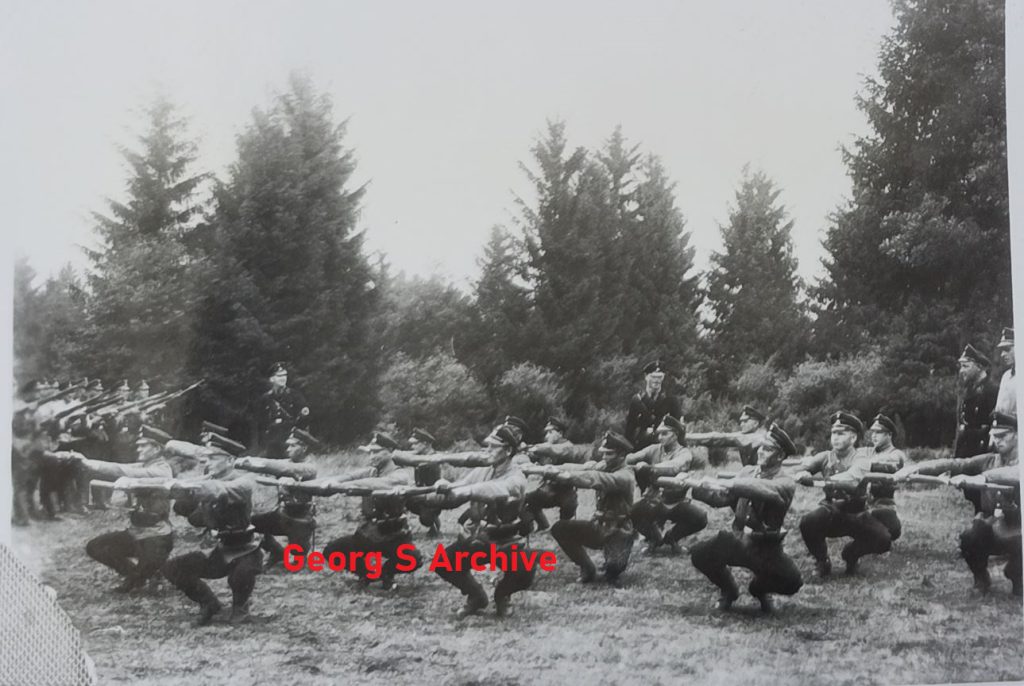
According to the Waffen-SS command, Ia, Tgb.No. 78/40 g.Kdos of August 1, 1940, it was ordered that current correspondence until July 31, 1940 should be carried out under the name Command of the Waffen-SS, Chief of Staff, Oranienburg, and all correspondence from August 1, 1940 to SS Command Headquarters, Waffen-SS Command, Berlin-Wilmersdorf, Kaiserallee 188. (Mehner, p.14)
With the establishment of the SS Leadership Main Office as the command authority for the military leadership of the Waffen-SS, an extensive reorganization of the existing Waffen-SS units took place.
New units were set up, existing ones were reclassified and others were dissolved. This also involved a change in the previous locations of the units.
This particularly affected the reinforced SS Totenkopf standards, which were issued on the orders of the SS-FHA v. On September 12, 1940, as part of the uniform orientation of all Waffen-SS units, they had to be reclassified according to the principles applicable to an Inf.Rgt (mot).
(DF 3/1973, p.23)
The SS-FHA, Ref.: 10n14/Ba/Pe v. September 25, 1940, warned on that day: “… There is reason to point out that according to the command of the Waffen-SS, Ia/Tgb.No. 78/40 g.Kdos from August 1, 1940 the inspection of the SS Totenkopf standards was dissolved. …” (Mehner, p. 14)
This order initially appears to have had little impact in the Dachau location area, compared to the Sachsenhausen-Oranienburg location, where there were also some replacement units or training units of the SS-TV??!!
October 5, 1940
SS-FHA, Ia, Tgb.No. 127/40 g.Kdos v. October 5, 1940 regarding
Relocation of the SS-T-Inf.Gesch.Ers.Kp. Dachau
Relocation from Dachau m.W. v. October 20, 1940 to Hamburg-Langenhorn, where the company was subordinated to the E/S “Germania” in terms of training and discipline.
As part of the reorganization of the Waffen SS replacement units, the company was renamed “SS-T-IG-Ers.Kp.” dissolved and now formed the “2.SS-IG-ErsKp.”.
1941
January 1, 1941
Renaming of the SS Totenkopf Artillery Replacement Department, Dachau, as of January 1, 1941, to III. Department of the SS Artillery Replacement Regiment and at the same time incorporated into the regiment.
(Vopersal, Sold., Kämpf., Kam, Vol. 1, p. 324)
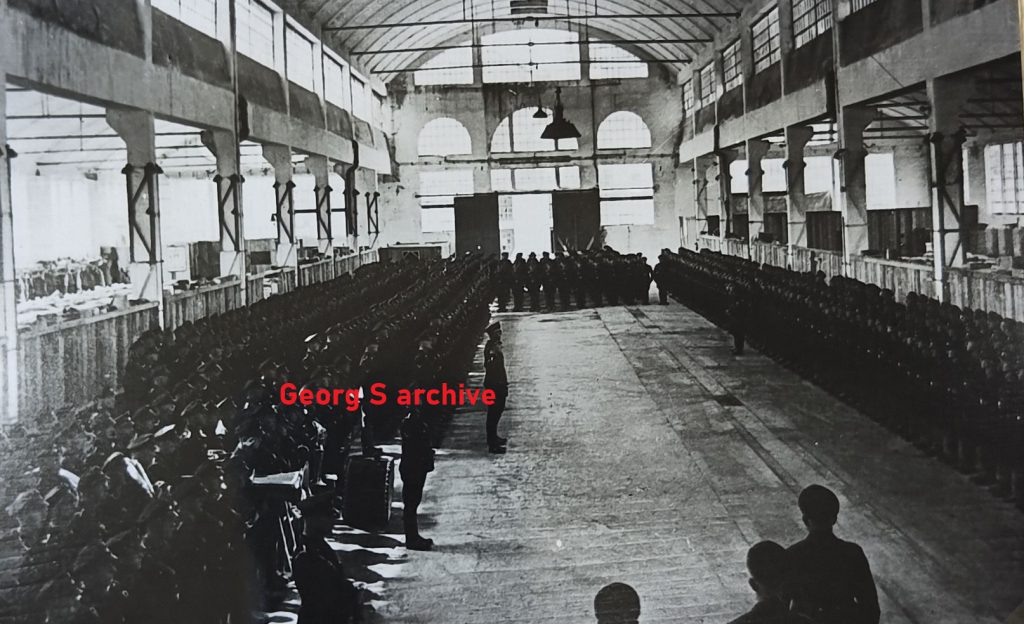
March 30, 1941
On March 30, 1941, the order to set up the
Replacement Administrative Services Unit 03/30/41 – 05/14/41
Replacement Department of the SS Administrative Services 05/14/41 – 05/31/44
Training and Replacement Department of the SS Administrative Services June 1, 1944 – April 27, 1945
in Dachau.
April 8, 1941
On April 8, 1941, the III. Department of the SS Artillery Replacement Regiment to Munich-Freimann. (Vopersal, Sold., Kämpf., Kam, Vol. 1, p. 324)
April 20, 1941
Promoted to Standartenführer, Gustav Diesterweg was appointed Commander of the SS Weapons Master School in Dachau, which was renamed again on September 1, 1941:
SS-Waffenmeisterschule München-Dachau 20.04.41 – 01.09.41
SS-Waffenmeisterschule München-Dachau
Waffentechnische Lehranstalt der SS München-Dachau 01.09.41 – 00.04. 20.04.41 – 01.09.41
From the information sheet of the SS-FHA, Weapons Inspection, for the careers of weapons master personnel in the Waffen-SS from September 1, 1941:
The Waffen-SS weapon master staff consists of:
I Weapon Master’s Assistant
II technical sub-commanders (W)
III technical guides (W)
You are responsible for maintaining and repairing the weapons and equipment.
General:
Admission conditions: Entry times and length of service according to the information sheet for joining the Waffen-SS as a volunteer, which is available from the SS supplementary offices.
For those named under I – III, only those men who can present the certificate of having passed the industrial skilled worker examination or the journeyman’s certificate from a chamber of crafts or guild of the completed practical apprenticeship as mechanics, machine fitters, machine builders, tool makers, tool fitters, gauge filers, are eligible for consideration. Precision mechanic or gunsmith. Applicants who have completed their apprenticeship in industrial companies will receive preference.
The request for employment must specifically express the desire to work as a weapons master’s assistant.
Service career:
I. Weaponmaster assistants:
1 year front service. In the last quarter of this year, the applicants will be sent to the military armory in the afternoon to prove their suitability for later use in the armory service.
At the beginning of the second year of service, those suitable are permanently assigned to the armory as assistants and receive further training in a special weapons master’s assistant course lasting 4 months at the SS Munich-Dachau Weapons Technical Training Institute. There will be an exam at the end of this course. Based on the results of this test, a decision must be made:
1.) Whether the examinee is suitable as a weapon master’s assistant in the troops or whether he is unsuitable for weapons technical services – if he is unsuitable, he returns to the front.
2.) Whether the examinee is suitable for a junior commander career in the weapons service. If you are suitable, you must attend a one-year non-commissioned leader course at the SS Weapons Technical Training Institute.
After completing the one-year course at the SS Weapons Technical Training Institute, those found suitable for a weapons-technical leadership career receive a further 1 ¼ years of training to become weapons-technical leaders at the SS Weapons-Technical Training Institute.
Participation in the sub-leader or leader course requires a 12-year service commitment.
II. Achievable ranks as technical sub-commanders (W):
SS-Unterscharführer to SS-Hauptscharführer
In the last years of the 12 years of service, it is possible to attend technical colleges for administration and technology, at the end of which the final examination I (lower career) or the final examination II (middle upper career) can be taken.
III. Weapons technical guides:
After completing the weapons master’s assistant course and after completing 12 years of service, if you are suitable, you will be assigned to a weapons technology course at the SS weapon technology training institute, which corresponds to the courses at a higher technical training institute. Training at the SS Weapons Technical Training Institute lasts 2 ¼ years.
These courses conclude with the technical examination. Leader (W) while simultaneously taking the engineering exam – specializing in mechanical engineering.
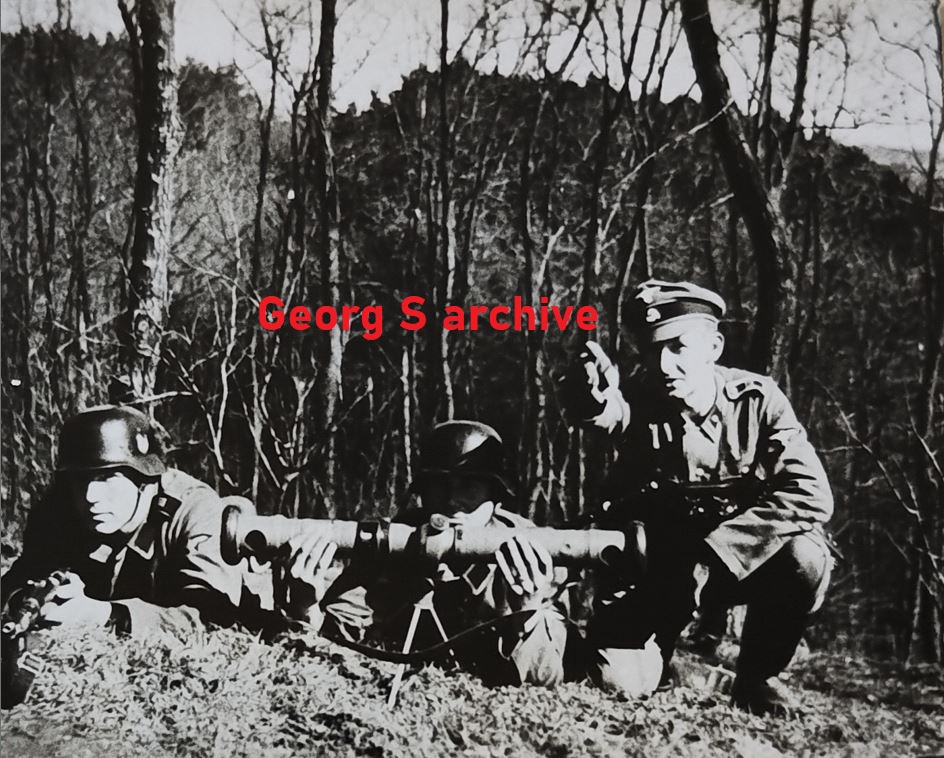
As a result, appointment as weapons technology leader and SS-Untersturmführer takes place after a total period of service of 4 ½ to 5 years.
Available ranks:
SS-Untersturmführer to SS-Obersturmbannführer
The technical leaders W who have not yet taken the final examination II (examination for the advanced technical inspection and acceptance service) due to previous weapon master training at an army weapon master school or who have not yet been able to take it due to the conditions at the time, have this examination at the weapons technology training college of the SS Munich – Dachau in order to be able to advance further through the position of SS-Hauptsturmführer.
Care and provision:
Care and provision for members of the Waffen-SS is carried out in accordance with Wehrmacht care in accordance with the SS Welfare and Supply Act. After being released from the Waffen-SS, a career as a civil servant is possible, especially in the police, secret state police, customs, etc. The most extensive financial support is provided when purchasing a settlement. Those who have served for 12 years receive a civil pension certificate.
(Jörg-M. Hormann, The Ordinance Gazette of the Waffen-SS – A Selection, Fitsch-Form-Verlagsgesellschaft Hannover, 1980, pp. 22-23)
April 24, 1941
SS-FHA, Ia/G./Keu, Tgb.No. 1484/41 go to v. April 24, 1941
Re: Composition of the Waffen-SS
According to the supplements:
32.) SS-Verw.Ers.Abt. Dachau
49.) SS-Standort-Kdtr. Dachau
58.) SS-Hauptzeugamt Dachau
65) K.L. mit SS-Totenkopfsturmbann (4 Kp.) Dachau
76.) SS-Sanitätsschule der Waffen-SS Dachau
80.) SS-Lazarett Dachau
90.) G.u.V. Prüfstelle Dachau
97.) SS-Bekleidungswerk der Waffen-SS Dachau
98.) Beschaffungsstelle der Waffen-SS Dachau
115.) Wirtschaftsinspektion d. Waffen-SS „Süd“ München-Dachau
119.) Heimatverw. d. SS-T.-Division Dachau
129.) SS-Standortverwaltung Dachau141.)
141.) SS-Verwaltungsschule Dachau
(Kurt Mehner, Waffen-SS und Ordnungspolizei, Norderstedt, 1995, S. 30-33)
September 1, 1941
On September 1, 1941, the SS Command Main Office, SS Medical Office, announced in the Waffen-SS Ordinance Gazette, 2nd year 1941, No. 16, Number 352 of September 1, 1941:
P.u.V. test centers:
a) For the G.u.V. testing centers, the name “Sanitary Inspection of the Waffen-SS” is no longer used.
From now on it says:
“Health and Usage Testing Center of the Waffen-SS Dachau”
or Prague or Hohenlychen.
The designation “Commander of the G.u.v. testing center” must now be replaced by the designation “Leader of the G.u.V. testing center.”
Furthermore, the designation “near the SS hospital Dachau” or Prague or Hohenlychen is no longer used. It is now only called “G.u.V.-Teststelle Dachau” or Prague or Hohenlychen. –
b) A welfare center for circulatory patients will now be set up at the G.u.V. testing center of the Waffen-SS Dachau. The G.u.V. test center Dachau and the welfare office report to the leader of the G.u.V. test center. –
SS members who require circulatory monitoring and are temporarily unfit for service are referred to the welfare office. –
(Jörg-M. Hormann, The Ordinance Sheet of the Waffen-SS – A Selection, Fitsch-Form-Verlagsgesellschaft Hannover, 1980, see also BA-MA N 756, Wolfgang Vopersal, G.u.V.-Prüfstelle Dachau, n.d., 1 page)
The G.u.V. test center in Dachau was dissolved at a previously unknown point in time.
(BA-MA N 756, Wolfgang Vopersal, G.u.V.-Prüfstelle Dachau, undated, 1 page)
November 15, 1941
After the first SS teaching kitchen was built in Oranienburg in 1940/41, a similar facility was also founded in Dachau a few months later.
In a notice in the Waffen-SS Ordinance Bulletin dated November 15, 1941, number 442, reference is made to the teaching kitchen in Dachau, but it was not yet in operation in September 1942.
The first course in Oranienburg did not begin until the end of July 1942. 24 troop cooks were trained there in two-week courses
(Hermann Kaienburg. The military and economic complex of the SS in the Sachsenhausen-Oranienburg concentration camp site, Metropol-Verlag 2006, pp. 340 – 341, see also note 560
December 15, 1941
Regarding the SS location headquarters in Dachau, according to the SS-FHA, Org.Abt. Tgb.No. 5539/41 from December 15, 1941: Reported to the SS-FHA, subordinate to the SS Dachau location command
a) a guard company in Dachau for the SS site guards and the Munich guard of honor
b) a guard company on the Obersalzberg for the guard of honor
c) the commanded company in Dachau
d) the SKD special column on the Obersalzberg
(see also Kurt Mehner, Waffen-SS and OrPo, p. 279)
End of part 5
Author Roland Pfeiffer, some Images Georg Schwab
SS-Standort Dachau (part 4)
We continue the serie about the SS-Standort Dachau which existed between 1933 and 1945.
May 16, 1938
By order of the SS Main Office, the SS Medical School Dachau was to be opened with effect from May 16, 1938 “for the training of medical students of the barracked SS”.
(BA-MA N 756 Wolfgang Vopersal, SS Medical School Dachau, n.d., 2 pages, here p.1, see also BA-MA N 756 Wolfgang Vopersal, SS Lazarett Dachau, n.d., 2 pages, here p.1, according to the circular of the SS-FHA from April 22, 1941 there were medical schools in Berlin, Dachau and Prague see also Hermann Kaienburg, The military and economic location of the SS in the Sachsenhausen-Oranienburg concentration camp site, series of publications by the Brandenburg Memorials Foundation, Vol.16, Metropol-Verlag , Berlin, 2006, pp.274-275, see also notes 326-328)
As a result of the overcrowding of all the accommodation rooms in the Dachau training camp with recruits from Austria, the first course was postponed and only began in the early summer of 1938. It lasted 6 months.
The school was affiliated with the SS Hospital Dachau, whose chief physician also ran the school according to the instructions of the SS Medical Office in the SS Main Office.
The permanent staff provided the SS standard “Germany” as well as the SS medical squadron SS-TV Dachau and the SS medical squadron SS-VT Munich.
The SS medical office regulated the identification of the teachers. The costs of the school were proportionally borne by the budget of the SS-Verfügungstruppe and the SS-Totenkopfverbandes. The students formed both units of the armed SS.
(BA-MA N 756 Wolfgang Vopersal, SS Medical School Dachau, undated, 2 pages, here p.1)
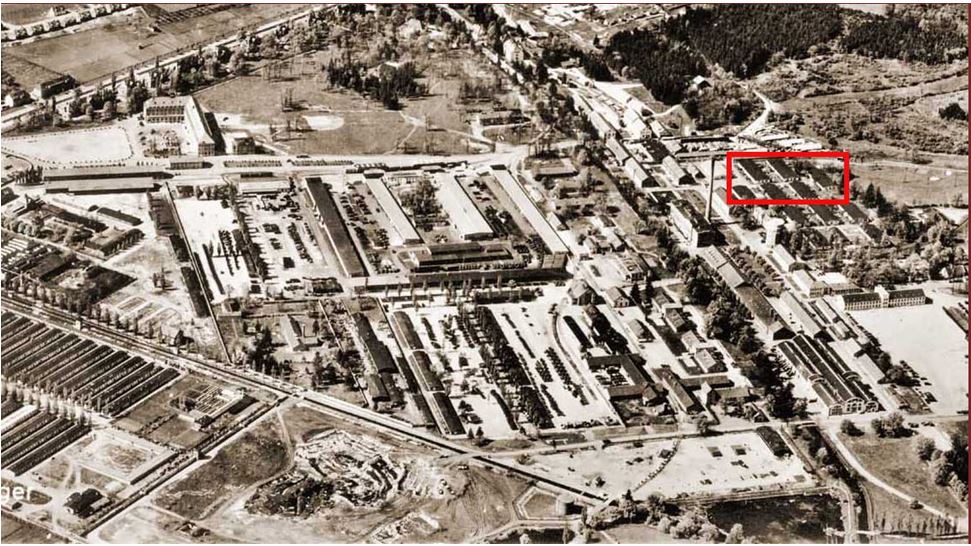
In the summer of 1938, the national method of counting the Sturmbanne was abolished; since then, the three Sturmbanne have had the numbers I, II and III, and the hundreds have had the numbers 1 – 12.
For the Hundreds, the time of the renaming is not entirely certain; the new numbering can be proven, among other things, for the 2nd Totenkopfstandarte in mid-1939 at the latest.
(Hermann Kaienburg, The military and economic location of the SS in the Sachsenhausen-Oranienburg concentration camp site, series of publications by the Brandenburg Memorials Foundation, vol. 16, Metropol-Verlag, Berlin, 2006, p. 163, note 125)
September 00, 1938
The I. and II. Sturmbann of the SS-T-St. 1 were deployed to the Ascher Zipfel in Czechoslovakia in September 1938. (Klietmann, Waffen SS, pp. 345-346, see also A.Mollo, Vol.4)
The I.-III./1.SS-Totenkopfstandarte “Oberbayern” were deployed in Ascher Zipfel (Czech Republic) to support the Sudeten German Freikorps “Henlein” before the Munich Agreement was concluded in September 1938. (Michaelis, Waffen-SS, Mythos, p. 309)
At the end of September 1938, before the occupation of the Sudetenland, which only took place zone by zone from the beginning of October 1938, Stubaf stood. Deisenhofer with his young men of the II. Sturmbann/1.SS-T-Sta.”Obb.” in the Asch area as the 2nd SS Battalion of the Sudeten German Freikorps and secured the Antonienhöhe in front of Franzensbad without any significant combat operations in order to prevent reprisals by the Czech army against the rebelling Sudeten German population. …
The Btl. Deisenhofer then took part in the military occupation of the German-populated area ceded to the German Reich as part of the army. (EG. Krätschmer, RK-Betrager, p. 314)
October 2, 1938
The SS-Sturmbann “N” took part in the invasion of the Sudetenland on October 2, 19438 – reinforced by an artillery department of the army and under the command of the VII Army Corps. He was assigned to the Neuern (Nyrsko) area and had the task of securing the demarcation line.
(Otto Weidinger, Division Das Reich, Volume I, Munin, 1967, p. 91)
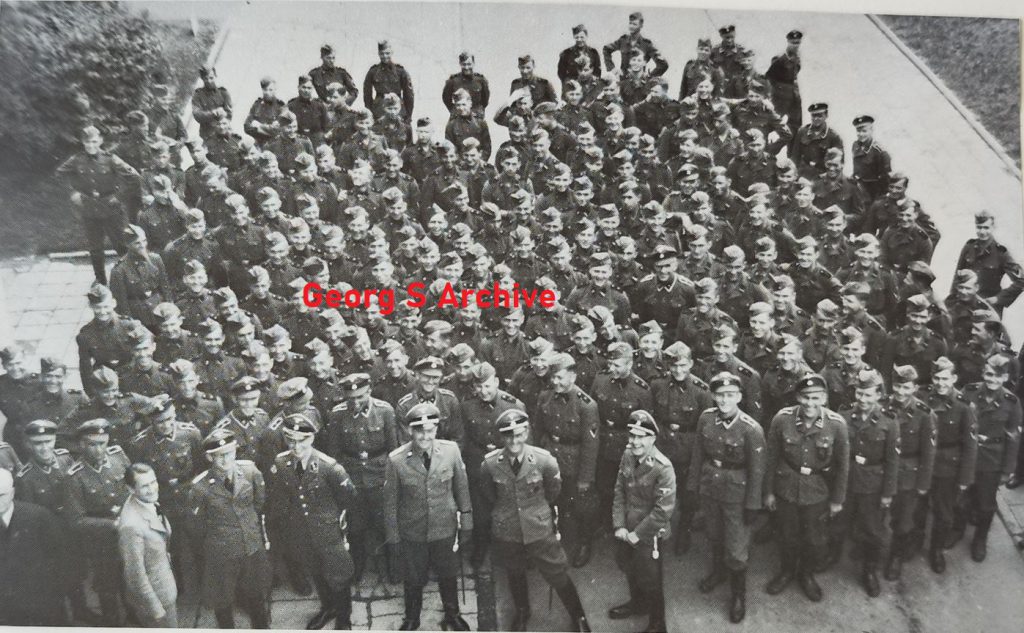
November 1, 1938
On November 1, 1938, the SS-Sturmbann “N” began to be reorganized into a motorcycle battalion.
Subordination to the official supervision of the “Germany” standard was abolished. With the previous IV Sturmbann SS-“D”, which was also reorganized into a motorcycle rifle battalion, SS-“N” became the regimental staff z.b.V. under SS staff. Walter Krüger subordinated.
The Sturmbann “N” was supposed to form the SS Motorcycle Rifle Battalion I in the regiment.
(Otto Weidinger, Division Das Reich, Volume I, Munin, 1967, pp. 91, 106)
Further construction work was planned for 1939/40, including the completion of barracks and garages for the SS-Totenkopf-Standarte “Oberbayern” and of SS accommodation and farm buildings for the KL headquarters.
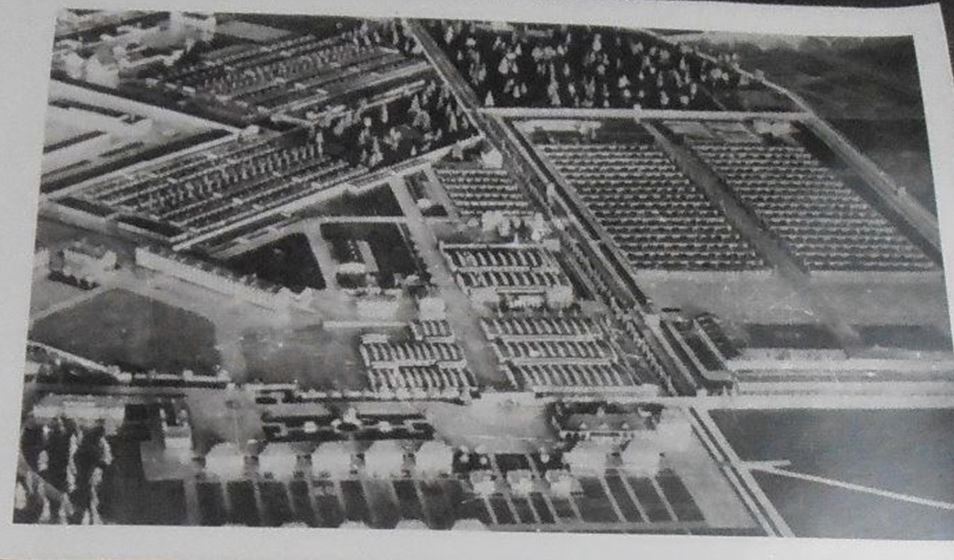
Furthermore, the construction of a new SS hospital and a clothing office was planned, both with the location name “Munich-Dachau”.
(Kaienburg, Wirtschaft, p. 122, see also note 17 Pohl to the Reich Ministry of Finance dated January 12, 1939 with 4 pages of appendix (list of planned buildings), BAB R 2.12 172)
March 12, 1939
In March 1939, the 1st SS Totenkopf Standarte “Oberbayern” was used in the occupation of the Czech Republic. (Michaelis, Waffen-SS, Mythos, p. 309)
Participation of the 2nd Motor Vehicle Company in the occupation of the rest of the Czech Republic: alarm in the evening, drive via Pilsen to Brno; Stay about 1 week, return via Vienna. (R. Messering, My Defense…)
During the occupation of Bohemia and Moravia in March 1939, the II. Stuba.der Sta., Stubaf. Deisenhofer, via Pilsen, Prague and Iglau to Brno and only returned to his home garrison six months later. (EG. Krätschmer, RK-Betrager, p. 314)
Helmut Büch: “… In March 1939 I took part in the invasion of Bohemia and Moravia with our unit. Our 11th company is then in Brno for a while…” (H. Büch, In 80 Close Combat Days, p. 12)
The SS-Sturmbann “N” did not take part in the invasion of Bohemia-Moravia in March 1939 because of the ongoing reorganization.
(Otto Weidinger, Division Das Reich, Volume I, Munin, 1967, p. 91)
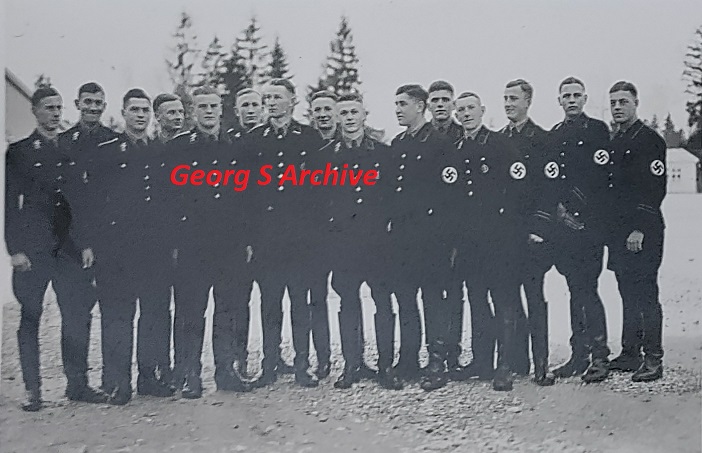


June 10, 1939
From June 10, 1939, the Kradschützen-Sturmbann “N” in the SS training camp began to be reorganized into an anti-tank department.
This meant that the Sturmbann SS-“N” had practically ceased to exist.
The tradition and with it the battalion flag of SS-“N” was taken over by the Anti-Tank Department/SS-VT.
Ellwangen was chosen as the future location.
(Otto Weidinger, Division Das Reich, Volume I, Munin, 1967, p. 91, there “July 10, 1939”, p. 111)
August 11, 1939
On August 11, 1939, the Panzer-Abwehr-abteilung/SS-VT, which only consisted of tribes, moved from the SS training camp to Ellwangen, where it was temporarily disbanded at the end of August 1939.
(Otto Weidinger, Division Das Reich, Volume I, Munin, 1967, p. 112)
August 25, 1939
With the mobilization, the connection between the 1st SS Totenkopf Standarte and the KL Dachau nominally ends.
An “SS-Totenkopf-Wachsturmbann” was formed for guarding from members of the “Police Reinforcement”, whose members had been trained for this purpose over the past few years and some had already been called up for various occasions (e.g. 1938).
The strength of this watch tower spell undergoes various changes during the war, and the composition also changes constantly.
September 20, 1939
The head of the SS main office in Berlin, September 20, 1939
Re: Handover of the SS training camp Dachau to the SS-Totenkopfstandarte “Oberbayern”
…
- With effect from October 1, 1939, the accommodation of the SS training camp Dachau will be handed over to the SS-Totenkopfstandarte “Oberbayern” for use and administration, unless this has already happened.
… - The commandant’s office of the SS training camp Dachau was dissolved with effect from October 1, 1939.
It has to complete its processing work by December 31, 1939. A decision will be made regarding the subsequent use of the SS leaders and SS sub-leaders who become free.
… - The administration of the SS training camp Dachau will remain in its current form for the time being. From October 1, 1939, it reports directly to the head of the SS Administrative Office
- The Commandant Building,
the hospital facility,
the district heating plant,
the weaponry,
the gardening,
the driver’s home,
the fittings forge,
the motor pool and
The community center with cinema remains initially subordinate to the SS Administrative Office and is managed by it.
… - The handover of the above-mentioned buildings and facilities must take place on September 29, 1939 at 9 a.m. by the commandant of the SS training camp Dachau to the head of the SS administrative office and to the leader of the SS-Totenkopfstandarte “Oberbayern”.
The head of the SS Haupt Office, signed Heißmeyer, SS Obergruppenführer
(T175 R40 picture 251 – 252)
From the end of September to December 1939, the SS Totenkopf Division was formed in Dachau. During this time, all accommodations were apparently occupied exclusively by parts of this division.
September 27, 1939
Between September 27, 1939 and February 18, 1940, the prisoners were transferred to other camps. Meanwhile, 7,000 members of the SS Totenkopf units were trained in Dachau. The prisoners were relocated: 2,138 to Buchenwald, 1,600 to Mauthausen, 981 to Flossenbürg. Only a work detail of around 100 prisoners remained in the camp.
October 20, 1939
From October 20, 1939, the SS Totenkopf Rekrüten Standarte was formed for newly drafted recruits of the SS Totenkopf units.
I. Sturmbann Dachau with tribes IV./IT SS-Ostubaf. Ernst Deutsch
II. Sturmbann Dachau with tribes V/IT SS-Hstuf. Kurt Laurar
III. Sturmbann Weimar with Trunks IV/2T SS-Ostubaf. Dr. Rudolf
Jacobsen
IV. Sturmbann Weimar from 2 Res.Kp. d. 3T SS-Hstuf. Heinrich Heinke
Initially, only a 1st and 2nd rifle company and a 4th (MG) company were set up per Sturmbann.
The II. Sturmbann is sometimes also referred to as the IV./5.SS-T Standarte.
The commander of this standard will be the previous commander of the 6th SS-T standard in Prague, SS-Oberführer Julian Scherner
(Marten van Dijken, SS-Totenkopfverband, self-published 2017, p. 98)
In December 1939 at least the III. Sturmbann appears to have come to Dachau.
Until the standard was disbanded in April 1940, at an unknown point in time
I. Sturmbann to Klagenfurt, the
II. Sturmbann relocated to Stralsund
III. Sturmbann was still in Dachau, the location of the
IV. Sturmbann is not yet known (June 14, 2018).
November 29, 1939
Order to relocate the SS-T Division from Dachau (and other locations) to the Heilbronn area (see also Vopersal, Soldiers, Fighters, Comrades, Volume 1, p. 45)
December 00, 1939
The SS Medical School Dachau was part of the General SS until November 15, 1939, but by order of the SS Main Office on November 16, 1939 it became part of the armed SS and was subordinated to the corps doctor of the armed SS.
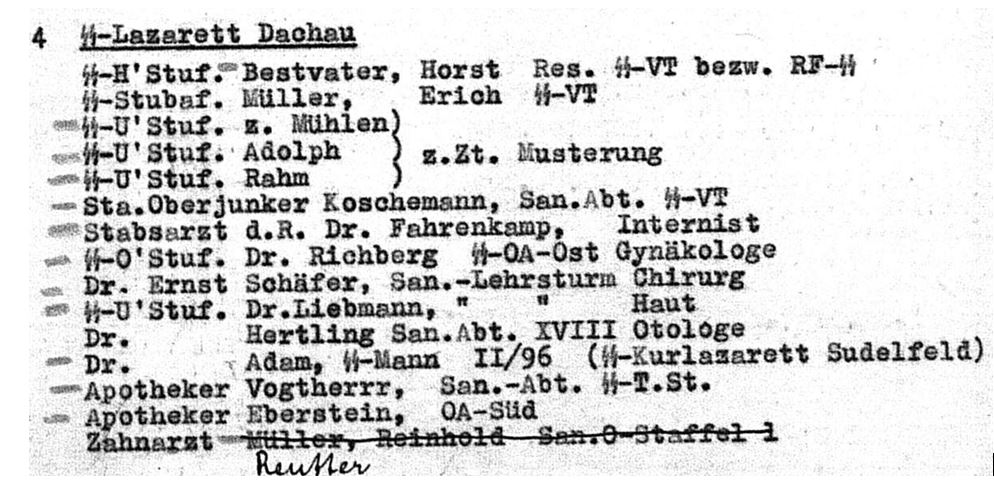
(BA-MA N 756 Wolfgang Vopersal, SS Medical School Dachau, undated, 2 pages, here p.1)
According to the “Personnel Order for Leaders of the SS San. Corps (in the original) of the Armed SS” from the head of the SS Personnel Main Office, SS-gruppenführer Schmitt (undated, probably October 1939, copy from NS 24-71 in the possession of the author. , possibly a draft, as handwritten changes were added), “with effect from October 10, 1939 … the following distribution of doctors, dentists and pharmacists in the armed SS occurred: …
In the “autumn of 1939,” although no exact date is known yet, a “circulatory testing center” was set up at the SS hospital in Dachau.
(BA-MA N 756 Wolfgang Vopersal, SS Hospital Dachau, undated, 2 pages, here p.1)
From December 1939 (?) the SS Medical School Dachau took over the training of medical ranks and stretcher bearers for the reinforced SS Totenkopf standards until September 1940. The courses lasted 2 months.
(BA-MA N 756 Wolfgang Vopersal, SS Medical School Dachau, undated, 2 pages, here p.1 below – 2 above)
1940
January 1, 1940
The SS-owned company “German Equipment Works” takes over the workshops and businesses that were established within the KL (locksmith shop, carpentry shop, saddlery…)
https://web.archive.org/web/20070311021032/http://www.km.bayern.de/blz/web/300017/chronik.asp
February 19, 1940
Alex Piorkowski became commander of KL Dachau until September 1942
https://web.archive.org/web/20070311021032/http://www.km.bayern.de/blz/web/300017/chronik.asp
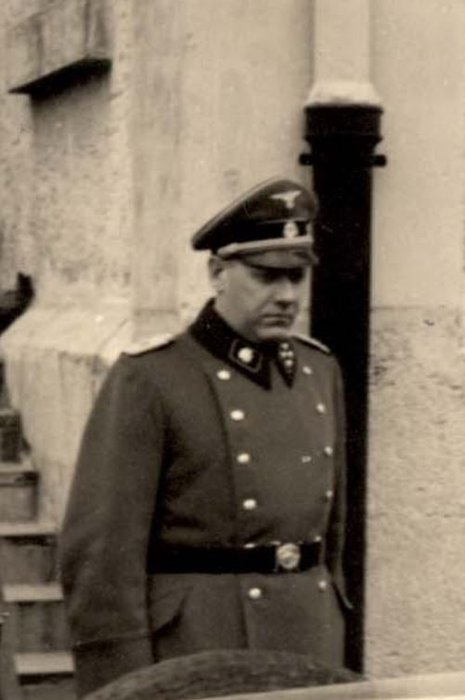
March 16, 1940
With effect from March 16, 1940, the previous “SS Circulation Testing Center Dachau” was expanded into a health and usage testing center (G. and V. testing center). The staff for this office was provided by the SS-TV (E) inspection at the SS main office.
(BA-MA N 756, Wolfgang Vopersal, G.u.V.-Prüfstelle Dachau, undated, 1 page)
The head doctor of the SS hospital in Dachau, the SS Sturmbannführer Dr. med., served as the commander. Fahrenkamp.
(BA-MA N 756, Wolfgang Vopersal, G.u.V.-Prüfstelle Dachau, undated, 1 page)
April 24, 1940
The RFSS – The General Inspector of the various SS-Totenkopfstandarten, No. 12/40 gKdos,
Berlin d. April 24, 1940
Re: Relocation of SS-T.-Standarten and SS-T.-Bataillons of the discontinued SS-Totenkopfstandarten
1.) … As III. Btl is subordinated to the 6th SS-T standard and the II. Btl (Stralsund) to the SS-T recruit standard….
2.) … The 1st Battalion (Klagenfurt) is subordinated to the SS-T Recruit Standard (the 7th SS-T Standard) as a further battalion. ….
3.) A 14th SS skull and crossbones standard is set up, which is intended for Denmark (probable location: Copenhagen).
It is composed of:
II./9.SS-T standard
III./6.SS-T standard
IV./ SS-T recruit standard
….
4.) A 16th SS skull standard will be re-erected. It is composed of:
III./SS-T. recruit standard Dachau
Rest I. and Rest IV./SS-T recruit standard
These two battalions will be replenished through supplementation.
Location: Prague (accommodations of the 6th SS-T Standard)
SS Standartenführer Herrmann (previously a police colonel) takes over the leadership of the standard. He received further instructions orally. The advance command of the III./SS-T recruit standard is to be marched immediately to Prague (orally in advance on April 23, 1940).
..,
7.) The I. and II.SS-ArtErsAbt, SS-Stubaf. Heldmann, and the IG-ErsKp are relocated from Oranienburg to Dachau after they have been transported away.
The above-mentioned units are to be marched to Dachau on April 24, 1940.
(Hausser, soldiers like others, p. 270 ff)
The relocation of the artillery replacement departments was related to Eicke’s attempt to separate the replacement units of the Totenkopf Division from those of the Totenkopf Standards. To manage his replacement formations, Eicke had created a new command staff in Dachau under the name “Inspector of the Replacement Units of the Totenkopf Division”, which now withdrew all replacement units assigned to the division from Oranienburg, the headquarters of the Totenkopf Standards.
(Hermann Kaienburg, The military and economic location of the SS in the Sachsenhausen-Oranienburg concentration camp site, series of publications by the Brandenburg Memorials Foundation, vol. 16, Metropol-Verlag, Berlin, 2006, p. 228)
May 6, 1940
Apparently on May 6, 1940, the SS Dachau location headquarters was formed. Their leader was the
SS-Ostubaf., Standarten-, Oberführer Dr. Rudolf Pfannenstiel 06.05.40 – (20.04.42)
(until August 1, 1943?)
May 8, 1940
Rgt. Daily order 1/39 of the commander of the replacement units of the SS-T Division from October 27, 1939:
Still in Breslau as “I. and II./E SS-TV” was reclassified with effect from October 27, 1939 and became
“Staff replacement units of the SS Totenkopf Division”
renamed.
(Marten van Dijken, The SS Death’s Head Associations 1933 – 1933, A Documentation, Volume II 1937 – 1939, self-published 2016, p.154, copy in the van Dijken archive)
The previous commander of the I. and II./E SS-TV, Erwin Reitz, who was promoted to SS-Obersturmbannführer on August 25, 1939, was appointed commander of the replacement units of the SS-Totenkopf Division.
(Marten van Dijken, The SS Death’s Head Associations 1933 – 1933, A Documentation, Volume II 1937 – 1939, self-published 2016, p. 154, there also photo Erwin Reitz)
In March 1940 “to handle all replacement matters of the SS-T-Div. in direct agreement with the commander of the SS-T-Div.” (Div.Order SS-T-Div./Kdr. dated March 28, 1940 regarding: Regulation of the replacement system) the office of the “Inspector (E) of the replacement units of the SS-Totenkopf-Division” based in Oranienburg near Berlin (until 7.5.40, then from 8.5.-11.5.40 Dachau near Munich).
This new office was responsible, among other things, for:
a) the replacement position of teams, clothing, equipment and equipment for the field units of the SS-T-Div
b) the compilation of replacement transports
c) the equipment of the marching units going to the front
d) the formation of a convalescent company
i.e. for all replacement matters of the SS-T Division. The department was also responsible for a uniform and new system
To manage the replacement units of the SS Death’s Head Division, Theodor Eicke had set up a new command staff in Dachau under the name “Inspector of the Replacement Units of the Death’s Head Division”, which now withdrew all replacement units assigned to the division from Oranienburg – the headquarters of the Totenkopf Standards.
(Hermann Kaienburg, The military and economic location of the SS in the Sachsenhausen-Oranienburg concentration camp site, series of publications by the Brandenburg Memorials Foundation, vol. 16, Metropol-Verlag, Berlin, 2006, p. 227 below – 228)
SS brigade leader Kurt Knoblauch is supposed to be there for a while
01.05.40 – 01.06.40 Inspector of the SS Totenkopf replacement units and commander of the
Replacement troop units of the SS Division “Totenkopf
01.06.40 – 24.12.40 1st General Staff Officer Ia of the SS Division “Totenkopf”
12/24/40 – 01/07/41 Commander of the Waffen-SS “West” (The Hague)
07.01.41 – 07.04.41 Commander of the Waffen-SS “Nordwest” (The Hague)
have been.
(Andreas Schulz, Günter Wegmann, Dieter Zinke, Generals of the Waffen-SS and Police, Volume 2, Biblio 2005, p. 537)
SS Standartenführer Wilhelm Bittrich is said to be from
15.06.40 – 00.00.00 Commander of the replacement troops of the SS-V and T-Division
have been.
(Kurt Mehner, Waffen-SS and Order Police, Norderstedt, 1995, p. 283)
June 00, 1940
In June 1940 the two SS-T-Art.Ers.Abt. I and II were combined in Abt I as “SS-T-Art.Ers.Abt”.
In addition to providing replacements for the SS-T-Art.Rgt, the department also provided personnel for the establishment of the lei in September 1940. Field howitzer battery for the SS-T-St.”K” in Norway.
End of Part 4. More will come
Author Roland Pfeiffer some images Georg Schwab
SS-Standort Dachau (Part 3)
Der Inspekteur der Konz.-Lager und Führer der SS-Totenkopfverbände, Berlin, den 1.April 1937
Befehlsblatt SS-TV/IKL Nr. 3 März 1937
Verteiler
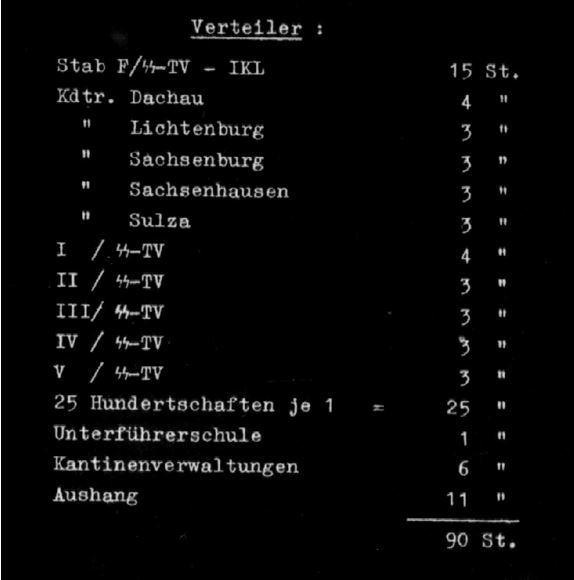
…
Nr. 15: Schulungsleiter der Hundertschaften:
Im Zuge der Neubesetzung der Dienststellen als Hundertschaftsschulungsleiter werden mit der Schulung einer Hundertschaft von mir beauftragt:
I./SS-TV „Oberbayern“
1. Hundertschaft
3. „
5. „
7. „
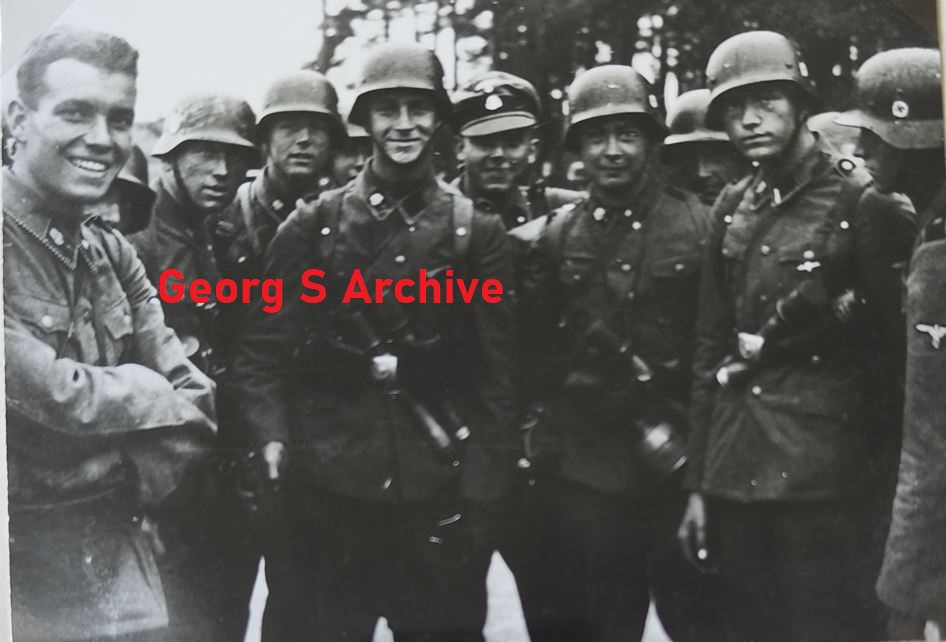
9. „
11. „
20. „
25. „
II./SS-TV „Elbe“
8. Hundertschaft
10. „
12. „
19. „
22. „
III./SS-TV „Sachsen“
13. Hundertschaft
15. „
17. „
23. „
IV./SS-TV „Ostfriesland“
2. Hundertschaft
4. „
6. „
21. „
V./SS-TV „Brandenburg“
14. Hundertschaft
16. „
18. „
24. „
(auf Namen jetzt verzichtet, geht nur um die Zusammenstellung der TV und die Hundertschaften)
…
Nr.19: Entlassungen:
SS-Untersturmführer Helmuth Poetsch, I./SS-TV „Oberbayern“

(T175 R40 Bild 0141 – 0152 ohne Zählwerk)
15.04.1937
In Dachau wurde eine „SS-Führerschule des Verwaltungsdienstes“ eingerichtet, die Lehrgänge zur Vorbereitung auf den SS-Verwaltungsdienst durchführte.
(Kaienburg, Wirtschaft, S. 120, Anm. 12)
Das genaue Datum der Einrichtung der Schule in Dachau ist leider bisher (13.6.2018) noch nicht bekannt – vorher liefen die Lehrgänge an der Junkerschule in Tölz, aber vermutlich handelt es sich bei dem am 15.4.1937 begonnen Lehrgang um den 1. , der in Dachau abgehalten wurde:
15.04.1937 1.Lehrgang für Verwaltungskunde Dachau bis (01.03.1938)
Gerhard Schill, bisher 1.Mitarbeiter des Korps-Intendanten des General-Kommandos SS-Panzer-Korps, ein Truppenverwaltungsfachmann als Divisions-Intendant an. Geboren am 13.November 1912 in Reutlingen, Württemberg, war er seit dem 1.Juni 1931 der NSDAP, Mitgliedsnummer 559 840. Der SS scheint er seit dem 1.1.1934 angehört zu haben, SS-Nummer 225 404.
Er absolvierte den 2.Friedenslehrgang an der damaligen SS-Führerschule Tölz vom 15.April 1935 bis zum 1.Februar 1936. nach dem er am 20.April 1936 zum SS-Untersturmführer befördert wurde. Bereits seit dem 1.März 1936 bis zum 1.Dezember 1936 war er Mitarbeiter der Verwaltung des II. Sturmbannes der SS-Standarte „Deutschland“, anschließend bis zum 1.April 1937 Mitarbeiter in der Verwaltung des SS-Oberabschnittes „Elbe“, vom 15.April 1937 bis zu 1.März 1938 nahm er an dem 1.Lehrgang für Verwaltungskunde Dachau teil und war anschließend vom 18.April 1938 bis zum 31.März 1941 Leiter der Verwaltung des III. Sturmbanns der SS-Standarte „Der Führer“. Vom 1.April 1941 bis zum 1.Juli 1942 war Schill 1.Mitarbeiter des Divisionsintendanten der SS-Division „Das Reich“ und seit dem 5.Juli 1942 bis zu seiner Versetzung als Divisions-Intendant zur „SS-Pz.Gren.Div. (10.Div.)“ am 10.Januar 1943, wie bereits erwähnt, 1.Mitarbeiter des Korps-Intendanten des General-Kommandos SS-Panzer-Korps.
06.07.1937
Der Führer der SS-Totenkopfverbände und Konzentrationslager, Berlin, den 6.Juli 1937
Befehlsblatt SS-TV/KL Nr. 6 Juni 1937
Verteiler:

(T175 R40 Bild 0105 – 0114 ohne Zählwerk)
15.09.1937
Am 15.September 1937 wurde auf Befehl des Reichsführers-SS, SS-Personalkanzlei, die SS-Führerschule Dachau „für Führer von Sturmbannen und Standarten“ errichtet. (s.a. http://forum.axishistory.com/viewtopic.php?t=117801)
The previous clothing warehouse was converted into the training building for a new SS leader school; The rooms were ready for occupancy on October 1, 1937.
It was the General SS leadership school, which only existed temporarily.
In the documents it is referred to as the “SS-Führerschule München-Dachau” or as the “SS-Führerschule Dachau of the General SS”.
In order to meet the higher demands of their participants, the previous accommodation of the employees of the SS business enterprises had to be redesigned accordingly.
(Kaienburg, Economy, pp. 119 – 120, note 12)
Whether this school was the “… third of the planned schools…” mentioned in October 1934, which “… was only intended to conduct troop leadership courses for company commanders, battalion and regimental commanders…” (B. Wegner, PS, P. 89 – 90, see also note 50, AHA of October 4, 1934, appendix S.2, lecture note T.A. of October 5, 1934, p.7, T 78/427/7594) is not known because the third school “for troop leadership courses” is completely unknown. (December 19, 2007, February 3, 2008)

“On the orders of the Reichsführer-SS, the new leadership school of the General SS was opened in October 1937. The school’s task is to familiarize the leaders of standards and Sturmbannen with their tasks in all areas of training and, above all, to achieve a consistent ideological orientation.
The school consists of a residential and teaching building. The commanded leaders are accommodated in groups of two or three in comfortably furnished rooms. Meals are eaten together in the camp’s forest casino.
The management of the school is subordinate to the SS-Oberführer Scherner, who is assisted by the SS-Obersturmbannführer Kommer, the SS-Obersturmführer Schmidt and the SS-Untersturmführer Fröbel as teachers, while the SS-Hauptsturmführer…” (end of the excerpt)

In the first half of 1938, the SS base received a new access road; In order to avoid passing through the city of Dachau, it branched off from Munich’s main street in front of the town and led almost a kilometer through the open field straight to the main entrance to the SS training camp.
(Kaienburg, Economy, p. 120)
This street was then named “Lagerstraße”. The previous “Lagerstraße”, which led to “Reichsschatzmeister-Schwarz-Platz” in front of the main entrance of the SS training camp to the concentration camp, was then renamed “Street of the SS”.
(Kaienburg, Economy, p. 120, note 14)
An existing building was converted in the spring of 1938 to set up an SS witness office.
(Kaienburg, Economy, p. 122, see also note 17: BAB NS 19-3691)
Since 1938 at the latest, there has been a weapons master training workshop in Dachau where weapons master courses were held.
During the war, the expansion to the “Dachau Weapons Technical Training Institute” took place, in which SS members received training as “Technical Leaders W”.
(Kaienburg, Economy, p. 122, see among others BDC file SSO Karl Plötz)
From the personal file of Karl Ploetz, born March 25, 1892
Master craftsman course from the 6th (according to another information from the 10th) 1.38 – 31.3.38 b. d. Dachau weapons master workshop, since September 11th, 1938 SS-Ustuf., “master craftsman in the weapon master service”, from October 23rd, 1939 from SS-T.Sta. 2 to the SS-T.Sta. 6, 9.11.41 east side,
Plötz had v. 1.2. – May 1, 1934 a weapons course i.d. Pole. Waffenmeisterei Papenburg, graduated, with the SS-TV since September 11, 1934 (John P. Moore, 1.2015)
From the personal files of Karl Georg Kriegel, born June 15, 1915,
Course at the (subsequently) “W.T.L. Dachau” facility from February 15th. 1938 – February 18, 1939, v. 1.6. – 8.9.39, as well
H.W.S. Berlin v. February 1, 1939 – March 1, 1940
Weapons technical course f. t. F. “W” v. December 1, 1940 – August 30, 1941
From August 27, 1941 SS-Ustuf. d.R. at the Waff.M.Sch. Munch. Dachau, later SS Westland (according to the master sheet), January 30, 1943 SS-Ostuf. d.R. (Andreas Biere, John P. Moore, 1.2015)
March 10, 1938
For the invasion of Austria on March 12, 1938, in addition to the existing SS-VT units and around 12,000 men of the public order police, three battalions/sturmbanne of the SS-Totenkopf-Verband “Oberbayern” from Dachau were placed under the army’s command – as a second wave.
The Totenkopfsturmbanne were used by the VII Army Corps mainly to secure bridges and roads. (Erwin A. Schmidl, The “Anschluss” of Austria. The German invasion in March 1938, Bernhard & Graefe Verlag, Bonn, 3rd edition (1st and 2nd editions appeared in the Austrian Federal Publishing House, Vienna, under “March 38 – the German invasion of Austria”, p. 139, hereinafter “Schmidl, Anschluss, p.”)
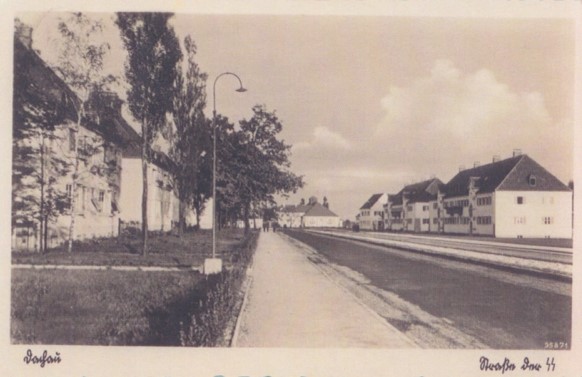
Über die Verwendung der SS-Verfügungstruppe war man beim Heer nicht allzu glücklich und ließ dies anscheinend die SS-Einheiten auch merken. Im Einsatzbericht des 1.SS-Totenkopf-Verbandes „Oberbayern“ wurde Klage geführt, dass „einzelnen Stellen des Generalkommandos (VII. Armeekorps) über Gliederung und Aufgaben der SS-Totenkopf-Verbände nicht ganz im Bilde waren…“, was vom Generalkommando mit einem lakonischen „Stimmt“ quittiert wurde. (Schmidl, Anschluss, S. 209, s.a. S. 288 Anm. 779 Erfahrungsbericht der 1.SS-Totenkopf-Standarte „Oberbayern“, Dachau, 6.Mai 1938 in BA-MA RH 53-7/ v. 127)
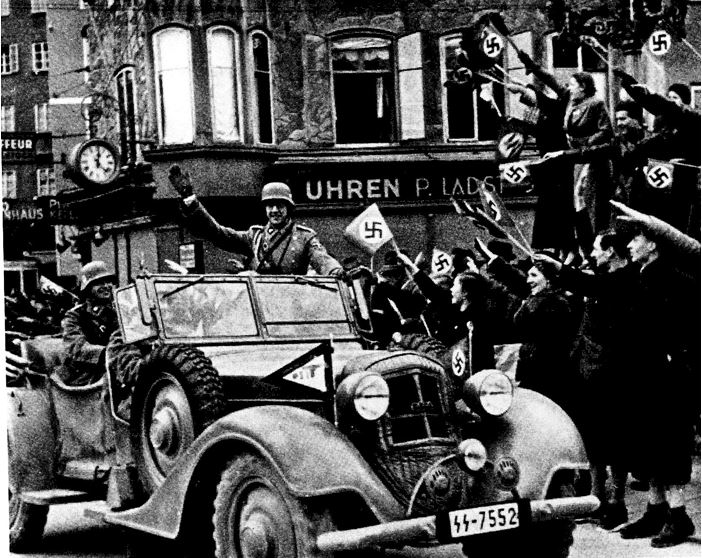
Der SS-Sturmbann „N“, Übungslager Prittlbach, nahm am Einmarsch in Österreich nicht als geschlossener Verband teil, die Soldaten wurden auf verschiedene Einheiten der Standarte „Deutschland“ aufgeteilt, um diese auf Kriegsstärke zu bringen.
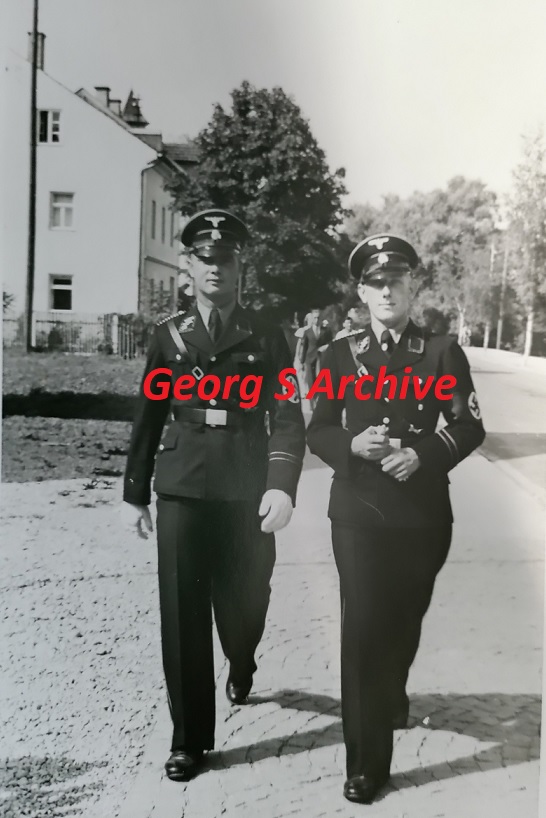
Nach der Rückkehr aus Österreich traten die abkommandierten Männer wieder zu SS-„N“ zurück.
Noch im März 1938 wurde SS“N“ mit Freiwilligen aus Österreich auf den vollen Mannschaftsbestand gebracht.
(Otto Weidinger, Division Das Reich, Band I, Munin, 1967, S. 90 – 91)
End of part 3
Author – Roland Pfeiffer – Some images Georg Schwab


